Prague Reading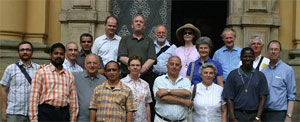
Philip Harvey, Librarian at the Carmelite Library, Middle Park
Positioned in 24K window seat to Prague via Dubai, any time of day, which turns anytime soon to night, can be spent touching the in-flight screen. A poke of the dropdown box gives eight pages of Essential Albums. A deft jab with the index finger will display enough movies to watch for several circumnavigations of the planet. A nudge with a knuckle gets the screen keeping constant updates on the flight, including camera shots of terra firma below and nimbus or cirrus or astra ahead. But interestingly, in all of this magical mystery tour of 2012 culture, not one text screen. Not one file of great Czech poems to inform the traveller of the Bohemian soul. Not one short essay by Vaclav Havel. Touching is changing how we access our listening, watching, and reading. It is changing how we access. The flight screen is an in-your-face reminder of the contemporary declaration that the fold is dead. Books fold, magazines crinkle, we dog-ear the page before taking a catnap. But the flat screen is altering the habits of a lifetime, if not precisely replacing them. A child of five knows which spot on the screen to touch next, quicker than I know how to find the table of contents in my compendious monographic companion. Travelling at a ground speed of 581 miles per hour toward Prague I choose instead to sit back and enjoy through headphones the sensationally great opera that had its world premiere in that city in 1787, Mozart’s ‘Don Giovanni’.
Information Technology Revolution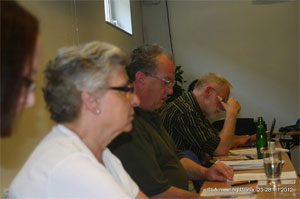 Rumours of the death of the fold are greatly exaggerated. Delegates at the Tenth Carmelite Librarians’ Meeting (Decima Riunione Bibliotecari Carmelitani) know in advance that the information technology revolution has clarified the role of librarians. In particular, it has shown us that books are not the main business of librarians. Our main business is the keeping of memory, the provision of reading, the selection of essential knowledge. By which I mean, reading in whatever form it may be presented, via whatever carrier the words are delivered. The codex, or fold, was not the first mode of transmission left to the care of librarians, and it won’t be the last. Nor do we hear laments from the rooftops for the loss of the fold, even if some of our borrowers ask inappropriate questions about whether librarianship is a thing of the past, now that ‘everything’ is online. Plainly our job is not to waste time explaining away their misconceptions, but to ask what it is they are looking for. Chances are we will have the answer, or know where to find it for them. More than likely the answer will not be online, but in the lines of a folding item in the library. Thus the conference kicks off, delegates ever sensitive to what our users read and how they read.
Rumours of the death of the fold are greatly exaggerated. Delegates at the Tenth Carmelite Librarians’ Meeting (Decima Riunione Bibliotecari Carmelitani) know in advance that the information technology revolution has clarified the role of librarians. In particular, it has shown us that books are not the main business of librarians. Our main business is the keeping of memory, the provision of reading, the selection of essential knowledge. By which I mean, reading in whatever form it may be presented, via whatever carrier the words are delivered. The codex, or fold, was not the first mode of transmission left to the care of librarians, and it won’t be the last. Nor do we hear laments from the rooftops for the loss of the fold, even if some of our borrowers ask inappropriate questions about whether librarianship is a thing of the past, now that ‘everything’ is online. Plainly our job is not to waste time explaining away their misconceptions, but to ask what it is they are looking for. Chances are we will have the answer, or know where to find it for them. More than likely the answer will not be online, but in the lines of a folding item in the library. Thus the conference kicks off, delegates ever sensitive to what our users read and how they read.
As the distance increases between writer and reader, reliant on robots as intermediaries, it is unsurprising that words have become text – undifferentiated and perpetual text. Streaming of information creates an illusion that one set of words is of equal value with any other set of words, just as the stupendous availability of music online has created the illusion that all music is simply downloadable product, without distinction, notated wallpaper. The word ‘robot’ is a Czech contribution to English vocabulary. In his science fiction play of 1920, Karel Capek introduces to the stage robots, who are mass-produced out of organic matter in a factory. These are artificial humans who can do all the work for humans, which is helpful, until some of them turn hostile and end up destroying the world, leading to the extinction of all humans. Not helpful, and not very bright. ‘Robot’ has a fraught history in English usage, as a robot can be a creative and practical extension of human utility, but also an unmanageable and dangerous threat to human potential. It can be a good servant, but a bad master. When it comes to reading, this paradox can have consequences. How much text can we take from the robots until it is all too much? The robots keep on keeping on. While the robots keep on sending text in unmanageable quantities daily, how do we, the fragile humans with our soft retinas, decide what is readable, and not? For every librarian replaced by a robot, there is one less conversation about knowledge that could make a difference to our future.
After Capek wrote his robot play he recognised that it was a re-telling, probably unconsciously, of a Jewish legend closely associated with the city of Prague: the legend of the golem. This Hebrew word occurs once in the Bible, at Psalm 139, 16. John Wyclif in English makes golem “unperfect thing”, out of which the King James Bible (1611) says “Thine eyes did see my substance, yet being unperfect; and in thy book all my members were written.” It seems to be variously translated inanimate matter, amorphous unformed material, unformed substance, or embryo, depending on your translator, but was used previously in the Middle Ages for a human made from the earth. In Jewish mysticism this clay person was brought to life by the insertion of a slip of paper with one of the mystic names of God, under his tongue, rather as we validate a ticket to go on the metro, or write in a password to go to the next part of a website. As with Capek's robot, the golem would then follow the directions of the one who created him. Related to this new found power over an inhuman human was the fear that the golem might get out control and take things into his own hands, making him a precursor of Frankenstein and other technological inventions that do the opposite of their creator's wishes. As with robots too, the golem in some stories turns on his own creator and kills him, thus exemplifying one of the more unhappy metaphors for human invention. Yehudah Liva ben Betsal'el, Chief Rabbi of Prague in the late 16th century, is the person given highest profile as the creator of the golem, and when I say 'creator' I don't mean literally, because the golem is created out of reading. Reading makes him so. He is a magical creature invented from stories, from a Jewish mystical tradition involving Hebrew Scripture, letters and numbers. That a golem might or might not exist seems to be at the heart of subsequent stories emanating from the Jewish Quarter of Prague. At different times in history there have been serious attempts to identify an actual golem, including unsuccessful inspections of the attic of the Old-New Synagogue in the city, where legend has it that a golem has lived in secret for centuries.
Caech Carmelite Treasures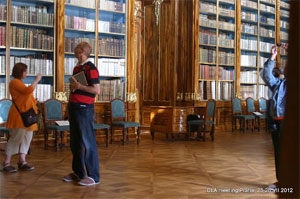
The Carmelite Czech Delegation welcomed delegates. We were given a potted history of Carmelite presence in Bohemia, which started in 1347, and not by accident at the same time as the founding of Charles University. In the first period there are no surviving books. They were possibly transported to Vienna, all lost. But by chance a liturgical book was discovered more recently, a book containing two late medieval books bound together. The first book is a little less than 100 years older than the second book. The first is a Gradual with Carmelite themes, circa 200 pages. It contains no name of a pope or emperor, but mentions Saint Wenceslas and one Bishop John, so must have been made before or around 1390. The book is so ancient that there is no reference to the Feast of Our Lady of Mount Carmel, a date that later became central to the Carmelites’ year. But Our Lady of the Snows is mentioned, with a special dedication, leading to the conclusion that the book must be Carmelite. (One of the great churches of the city is named for this dedication.) The colophon to the second book is dated 11 April 1473. The book contains a Latin poem about a legend of Mary in which it snows in Rome in August. This legend is related to the formation of Santa Maria Maggiore, the basilica church in Rome dedicated to the Blessed Virgin Mary. These books had been used by Benedictines for their Christmas Vigil. It was only through reading an article in a journal that the attention of local Carmelites was drawn to this bound set, and thus a link with their more remote past. Today the historic volume is held in the National Museum at the top of Wenceslas Square. Such stories remind us that generations of readers gave their complete attention to the ultimate meaning of the words of worship, only very secondarily to such niceties as provenance or date. The words themselves, properly used, their meanings repeated and learned, make redundant the demands of time and place. In hearing about the two books in one, I could not help seeing it as a descriptive metaphor of Bohemia itself, in which different periods of history, at odds with one another, are squashed together unceremoniously. The physical layout of the city, seriously attractive as it is, is also a record of historical periods pressed against one another. It is left to the visitor to differentiate one thing from another, one period from the next, as for the locals this has already been absorbed, the continuities registered.
Discovering Prague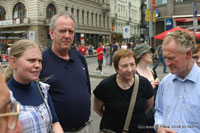 Going out into the city, there are various ways of finding your bearings. You can download the Prague App, which gives a full guide to the city simply by hitting your hand screen. A couple of delegates took this option. ‘Top 10 Prague’ (D&K Eyewitness Travel, 2011, c2003) is big on main features, contains lift-out maps, and has a droll commentary (“… architecturally it embraces every epoch from Romanesque to the Brutalist style of the Katva department store.”). This full colour Baedeker has clearly not been updated however, as the Globe Internet Café (“An expatriate institution”) I found closed, empty and covered in graffiti, due to the onset of wifi. Indeed, at airports, hotels, and every other tourist locale, it is now assumed that the traveller has her own laptop and can just plug in. I could find only one internet café in all of Prague, down a side street, rate of one crown per minute. Or, if you are a Melburnian for whom sitting for hours on trams is a form of spiritual sustenance, then the way to discover Prague is to buy a 110 crown all-day ticket and let the next tram take you where it will. Prague is blessed with one of the best tram (Habsburgs) and metro (Soviets) systems in the world. Furthermore, English readers are privileged everywhere they travel, as most public signs are in Czech and English.
Going out into the city, there are various ways of finding your bearings. You can download the Prague App, which gives a full guide to the city simply by hitting your hand screen. A couple of delegates took this option. ‘Top 10 Prague’ (D&K Eyewitness Travel, 2011, c2003) is big on main features, contains lift-out maps, and has a droll commentary (“… architecturally it embraces every epoch from Romanesque to the Brutalist style of the Katva department store.”). This full colour Baedeker has clearly not been updated however, as the Globe Internet Café (“An expatriate institution”) I found closed, empty and covered in graffiti, due to the onset of wifi. Indeed, at airports, hotels, and every other tourist locale, it is now assumed that the traveller has her own laptop and can just plug in. I could find only one internet café in all of Prague, down a side street, rate of one crown per minute. Or, if you are a Melburnian for whom sitting for hours on trams is a form of spiritual sustenance, then the way to discover Prague is to buy a 110 crown all-day ticket and let the next tram take you where it will. Prague is blessed with one of the best tram (Habsburgs) and metro (Soviets) systems in the world. Furthermore, English readers are privileged everywhere they travel, as most public signs are in Czech and English.
European Reformations
The privilege of reading is an originating cause of the European Reformations, the Czech version of which defined national character. What is the Christian religion? The foundation words of the Gospel? The practices that arose out of those Gospels? In every generation we observe the pull between the knowledge setting of society and how Gospel is used to interact and interpret that setting. The Catholic priest Jan Hus knew his Wyclif. Wyclif translated Scripture into the native tongue and believed that the uneducated could understand the words just as well as the educated, the laity as well as the clergy. His sermons were direct expositions of Scripture itself, something not common from pulpits at the time. Scripture may be, indeed must be read in the vernacular, where it is available to all. Hus was not some local Prague troublemaker, he was the Chancellor of the University, and the challenge he gave to the established order in Bohemia was to have vast repercussions across Europe, one hundred years before Martin Luther. He preached in Czech, inspiring both aristocracy and the common people. How do we read Scripture? And who has control of the interpretation? Hus placed Scripture as superior to church authority, indeed as the only authority, making himself predictably enough unpopular with church authority.
The abiding influence of Jan Hus on Czech identity is evident in many subtle ways in Prague. Their way of noticing the opposite position and veering towards it, is one basic example. When Hus was betrayed and killed at the Council of Constance (1414-1418), his martyrdom forced the latent divisions within Bohemian society. War followed and, eventually, the assertion of Habsburg authority over the country. When the Catholic Reformation reasserted the power of Rome (and Vienna), one way was to build vast and impressive buildings. The term re-Catholicisation is used in their history books for the process. This mission strategy by architecture resulted in two of the most impressive building complexes in Prague, the Loreto and the Clementinum, the latter an educational institution built by the Society of Jesus upon a Dominican foundation. It shouldn't be a surprise to learn that the indefatigable Peter Canisius SJ was responsible for the construction: is there anywhere in the world he didn't go? Today the Clementinum is not run by the Jesuits, but houses the National Library. It holds the national treasure, an 11-th century illuminated Gospel Book called the Codex Vyssegradensis, which records the foundation of the kingdom of Bohemia as well as containing the earliest known representation of the Tree of Jesse. As though to keep things in balance though, the library also contains original documents signed by Jan Hus, the surviving library of astronomer and alchemist Tycho Brahe, and a superb collection of Mozartiana. A deal was announced last year with Google Books for two hundred thousand Czech books in the Clementinum to be digitised for common use, nearly all imprints between the 16th and 18th centuries.
In ‘The Secret Miracle’, a short story by the blind librarian Jorge Luis Borges, the main character, a playwright named Jaromir Hladik, has a dream about the Clementinum where the librarians look for God in the books of the library. Borges wrote this story during the Second World War, when Prague was occupied by the Nazis. Hladík, who is living there during the occupation, is arrested and charged with being Jewish as well as opposing the Anschluss. He is sentenced to die by firing squad. He goes through raw terror at the prospect of death, but then turns to an unfinished play, titled ‘The Enemies’. His previous works he feels to be unsatisfactory and wants to complete this play, the one by which history will judge and vindicate him. With two acts left to write and his death sentence imminent, it seems impossible that he could complete it in time. On the last night before his death, Hladík prays to God, requesting that he be granted one year in which to finish the play. That night, he dreams of going to the Clementinum, where one of the books contains God within a single letter on one of the pages, which the cranky old librarian has been unable to find despite looking for most of his life. (Interestingly, in Borgesian terms, he complains of almost going blind looking for this letter.) God is in one of the letters of one of the pages of one of the four hundred thousand books of the Clementinum. Someone returns an atlas to the library; by chance Hladik touches a letter on a map of India and hears a voice that says to him, "The time for your labour has been granted". The next day at the appointed time, two soldiers come and Hladík is taken outside and lined up before the firing squad. The sergeant calls out the order to fire. Time stops. The entire world becomes motionless, including Hladík himself, standing in place before the firing squad. However, although he is completely paralysed, he remains conscious. After a time, he understands: God has granted him the time he requested. For him, a year of subjective time will pass between the sergeant's order and the soldiers firing their rifles, though no one else will realize that anything unusual has happened - hence, the secret miracle of the story's title. Working from memory, Hladík mentally writes, expands and edits his play, shaping every detail and nuance to his satisfaction. Finally, after a year of labour, he completes it; only a single epithet is left to be written, which he chooses, and time begins again and the volley from the soldiers' rifles kills him.
How to preserve the past
It was not possible for anyone to look for this letter during the week of the Meeting as the Clementinum was closed for repairs. Alchemy and numerology had to wait; the delegates had to look elsewhere. Meanwhile our conference enjoyed raising the perplexities of reading and storage. We heard about the ageing of print. The text on photocopies using outdated chemical methods is literally disappearing before our eyes. Yet the instant solution of digitising these rare copies is itself risky if, as we are being warned, the CD or the file itself could become redundant or inaccessible as one technology supersedes another. What will last and what will not? Built-in obsolescence is nothing new and can make new into nothing. We hear about reprint books where the old lettering blurs on the flat page, rendering words illegible. We can see the letters perfectly in the incunabula, but the 21-st century reprint turns them into swatted flies. Print-on-demand, an astonishing publishing explosion directly caused by the digital revolution, is a mixed blessing. A scanner that misinterprets accents produces a book that is a schemozzle of indistinguishable signifiers and signifieds. This must be particularly problematic with Czech, a language bristling with acutes, haceks, and dipthongy things. O, one utters, for the ancient text in all its papery glory! Spinoffs of this sort glut the market, ghosts of the originals, and not least on Amazon.
The keyboard itself has entered a whole new era, now that computers can only be spoken to by keying and mousing. There are times when we speak our mind to the computer, but that’s another matter, and only a matter of time. The qwerty has become the subject of international dispute, where nerds with time on their hands may write petitions for a better way of arranging the letters. These arguments do not have much leverage while qwerty is an historical and international reality as fixed as diplomacy. Having said that, Czech keyboards are fun for the novice, as their range of diacritics requires extra keys and registers. (The Arabic keyboards at Dubai Airport had more graphemes than there are stars in the sky above.) This led to a comedy of errors when I needed to send emails, as my passwords included figures that are located in unorthodox Czech parts of the console.Frustration gave way to relief as it was explained how the settings can be changed from Czech to English via a feature on the toolbar. The keyboard has become our means of touring the internet, our readiest way of finding what we wish to read next, our search guide for reading the newspapers, but it is fallible and prone to error.
Everyday the newspapers are full of all the most awful news about what humans can do. Even though we tell ourselves we will stop reading the newspaper, enough is enough, still we go back and read more of this awfulness. We seem to have a compulsion to go back for more, taking it all in with private relish and reacting in the same old appalled way. These thoughts were given, but much more succinctly and in perfect German, by Franz Kafka in his diaries. (One of the most famous entries is for 2 August 1914: “Germany has declared war on Russia. Went swimming in the afternoon.”) I relate Kafka’s thoughts from memory as I do not have the Diaries in front of me. Newspapers. Does anyone still cut columns from them to paste into scrapbooks? Does anyone cut and paste from online newspapers and store them in their cloud? And if so, do they go back and read them later?
Franz Kafka was a writer I discovered when I was at secondary school. His effect was direct and subversive. Perhaps his best known story today is ‘Metamorphosis’, about a young man who wakes up one morning to find he has turned into a cockroach. An insect at least, but always cockroach in my mind. Even today, after living with this story half a lifetime, there is still something utterly shocking about it that defies easy explanation. He wrote ‘The Trial’, a novel about a man who is arrested for a crime that he doesn’t know about, but by the end has come to believe he is guilty of committing. And then there is ‘The Castle’, another story about sinister and inexplicable bureaucracy that controls people’s lives. All of these stories express the state of existence in late imperial Prague, most evidently ‘The Castle’ because the inner city is overseen, from almost any river vista, by the immense hilltop edifice known as Hradcany Castle. Kafka was a novelist deeply aware of the multiple demands for attention on the modern educated reader, hence his agony about why he wastes so much time reading newspapers. He knew that there was no point writing a novel unless it was going to have an immediate and lasting impact on the reader. “A book must be the axe for the frozen sea within us,” was not said by someone intending to produce a nice read, or who saw reading as simply a way to pass the time. Any book written by Kafka had to be powerfully memorable. It had to change your life. It is this high personal expectation that is behind Kafka’s directive to destroy all of his manuscripts at his death. Fortunately his literary executor defied the author’s wishes, which is why visitors to Prague today can seek out the city’s Kafkaesque aspects, whether obvious or not.
Strahov Monastery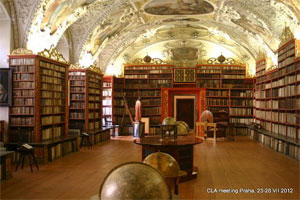
One morning our Carmelite guide distributed the tram tickets for our trip through town, across the Vltava and up Hradcany to the Strahov Monastery. This is one of the great historic landmarks, founded around 1140 and the scene of the fortunes of Prague itself: false starts, constructions, additions, fire, plunder, rejection, reclamation, repairs, triumphs, disasters, quiet, noise, looting, closure, destruction, decoration, re-opening, almost everything but defenestration. Holy people do not throw people out of windows. Ushered through large portals and long corridors we arrived at an unassuming door that led us into one of those library rooms we only dream about. Heavy floorboards led the eye inward toward the invisible point of perspective. Sunlight glowed across shelves matched strictly to the height of the books, surely nothing after 1900. Above us swirled one of those Baroque stucco ceilings that seem to have been modelled on whipped vanilla icecream. Frescoes circled above us as well, each one containing a scene with a scriptural passage that links knowledge with Wisdom. Above the door was painted the well-known saying: Initium sapientiae timor Domini (Psalm 110). This is the Theological Hall, completed in 1679. We put our shod feet into big felt slippers in order to slide across the boards without making a dint. It was difficult to restrain the temptation to pull large folios from the shelves, to read their title pages, to check out the inscriptions, to gaze inside some of these rare imprints, to listen to long ago theologians forwarding a premise. Not only is the readerly impulse as natural as breathing to a librarian, so is the interest in finding out how the books are arranged, how did they bind that multi-volume Augustine, and what is the truly rarest, by which we don’t mean the oldest, of all the books. (Google Image ‘Strahov Monastery’ if you are wondering what I am talking about.) So many rarities, so little time.
The monastery is Premonstratensian and even though the library rooms themselves are post-medieval it is unavoidable in such a setting not to think of the different kinds of reading practised by those Benedictine men throughout the Middle Ages. The existence of the book as a practical means of individual memory evolves in that period. Single manuscripts of theology were circulated to houses, where they would be read aloud (lectio) and in silence (meditatio) until the readers had memorised the contents. Public and private reading were organised for optimum remembrance. The ideas promoted in such works then became the personal knowledge of each reader, their added collective possession. The teachings became their teachings, though dispute was inevitable where newfangled notions were introduced. When it came to worship this was all the more important. It becomes self-evident that a single illuminated missal, or other liturgical or scriptural work, would be treated with the utmost care and reverence by individuals for whom this was the only copy in their house and maybe the only copy they would use in a lifetime. The words were their way into wisdom, so methods of reading, whether voiced or studied in silent retreat, were vital to existence. We can see, in such a world, why the coming of the printing press had such a rapid effect on their way of life, and also on their actual ways of thinking, trained as they had been for generations in reading solitary texts, solitarily together.
One of the most exquisite practical objects in the Theological Hall at Strahov is a rotating desk. Called a compilation wheel, it has ledges taking three or four books each, fitted into a circular hold that can be turned by a handle. The ledges keep to the horizontal by gravity, the engine having about six or eight of these ledges, so that a reader or translator can have as many as a dozen or more books open at once at a glance. This 17th century marvel provides ideal service for intertextual research, with no fussy delimiting of screens, tiresome online searches for forgotten quotes, or piles of sources to trip over. It is an object lesson in the needs of the Renaissance and Enlightenment reader, who worked with many texts at once and would work for the first time with many of them open, pages turned at a moment’s notice. With the tip of a hand a small library of books was available to read, all in real time.
Another exquisite object is in the adjoining Philosophical Hall of Strahov Library. It was all explained to us in impeccable Czech by the librarian, then through our charming translator into English. A tall free-standing cabinet bookcase is situated along one side of the room. It was the gift of the Austrian Princess and second wife of Napoleon Bonaparte, Marie Louise. In the autumn of 1812 she sent books to Strahov, a Viennese set of porcelain, and a four-volume catalogue listing the printed works in the first Louvre museum. This set was a piece of high culture propaganda, a political stunt masterminded by the French Emperor himself. However, when the exclusive publication was completed, he had the whole print run destroyed, after it was explained that it listed a large number of works that had been looted from other countries during his campaigns, most especially Italy. The Bonapartes’ propaganda coup turned into what nowadays is laughingly called a public relations disaster. Even as the donation was being received Napoleon was engaged in his ill-conceived Russian invasion, thus in a very short time leaving Prague with one of the handful of first edition Louvre catalogues still in existence. It is safely locked behind the cabinet glass, a curiosity kept from the cataclysm, like so many curiosities in this place. The reader can only wonder at libraries lost and found as she studies these grandiose records of unbridled ambition.
Information and Propaganda
A developed reading habit will begin to distinguish between information and propaganda, between the presentation of the words and their maker’s intentions. We were reminded of this truth after leaving Strahov Monastery and arriving down the street at the Archbishop’s Palace, directly adjacent to Hradcany Castle. The plan was to say Mass in the chapel of the Palace, but first our Carmelite guide, the erudite Father Gorazd Cetkovsky, told us a story at the castle gate about Josef Beran, Archbishop of Prague from 1946 until his death in 1969. In 1948 the archbishop declared in a sermon that the Catholic news in Czechoslovakia was not official but was being controlled by the Communists. At the time church services were being interrupted by hecklers and at this service the Reds derided Beran, whistled and yelled loudly. In a detail already suggestive of legend, Fr Gorazd said that the children in the church ran crying to the altar, which one took to mean a place of security for the children. Consequently the archbishop was put under house arrest by the State, leaving one to ask: what are we reading? What reading is official? What official publications are in fact not official? What do the officials want us to know? When living in a police state, either pre-1945 Nazi Prague or post-1948 Soviet Prague, how much is being made public? What is being repressed? Especially when the organization is the church, which philosophically disagrees with the State but publicly maintains an appearance of cool agreement with or tolerance of the State, simply in order to survive? Beran was separated from his people and his diocese for twenty years. Ordinations were conducted secretly, sometimes in the small chapel that we were about to worship in. Unable to minister properly to the congregations and their clergy, Beran lived a life of suffering and prayer. When Rome advised that it wished to make him a cardinal, the Communist authorities told Beran that if he went to Rome he was not to come back. After painful deliberation he left Prague, attending the last session of the Vatican Council, and dying in Rome. It was therefore with a sober sense of history and religious commitment that we filed through the large rooms of the Archbishop’s Palace and into the ornate Baroque chapel, aware that for all its beauty this was a place of prolonged imprisonment, suffering, and dedicated service.
Unexpected Support
An unexpected course of behaviour is recounted in an essay by the novelist Milan Kundera. Himself an atheist, Kundera started supporting the Christians through this period, and even started going to Mass, when he saw them being bullied publicly and privately by the Communists. We may call his reactions honourable; they were also very Czech. Czechs are conscious of their religious inheritance, even when they disagree with the religion, and see any outside imposition of injustice as unacceptable. Obviously Kundera’s reactions have a political motivation as well, but he was defending the freedom and right of religion. To judge by his essays, Milan Kundera’s central belief is in literature, and in particular the centrality of the novel as the locus of changing human consciousness. In this respect he is not very distant from Franz Kafka. Anyone who believes that the novel says it all, or says it best, will have an enormous faith in readers. He must also of necessity have faith in the reader to get it right. Kundera represents the Western Humanist tradition that says a creative fiction has its own internal life and references that can only be fully appreciated inside the reading life of that fiction. It is therefore easy to understand why Kundera disapproved of the film of his novel ‘The Unbearable Lightness of Being’, set in the period of the Prague Spring in the late 1960s. In the Czech edition of the book, Kundera remarked that the movie had very little to do with the spirit either of the novel or the characters in it. As a result of this experience, he continued, he was no longer allowing any adaptations of his works. Such a standoff plays right into the purpose of one of the most common conversation openers in society today: was the film as good as the book? Or, would you read the book after seeing the film? Et cetera. We have become so used to book and film being interchangeable units, as though one were the same as the other, that we have lost sight of the quite complex differences that exist between the visual and the print media. Kundera will be saying in words a hundred things that a film can only hint at, or cannot communicate at all. How can it? Likewise, in a few frames we can see graphic reconstructions of the events of August 1968 in Prague that Kundera must either stretch to make credible or assume the reader knows about beforehand. The novel has philosophical and literary connections from page to page that a filmmaker may only be able to transmit by a choice of poses, sets of shades, or symphonic hints. While Kundera may be right to give up on the idea that a film can ever say what he says, the belief that a film could do that anyway is in itself a mistake. Without being a snob about it, Milan Kundera’s decision seems to be based on the belief that the reader will only really be able to understand him by reading his words. The relationship between writer and reader is fixed on the page; everything else, films included, is commentary after the fact.
Meditation, prayer and new technology
The library conference continues behind closed doors in the nearby inner suburb of Karlin. A session on the new gadgets prompts repeated imaginary questions about the future. If tablets and smartphones become our first mode of reading, is there something we are also losing in that exchange? When a handheld device contains all of our reading for the next month, are we even thinking of visiting a library? Will the touchscreen really replace flimsy old breezy old paperbacks? Will there come a day when everything can be found in an ebook? Or are we creating a world divided into ebook available versus ebook unavailable? Can we concentrate for as long at a screen as we can at a paper page? Is medieval meditatio, the practice of reading at depth in silence, better done on some new untested microchip mechanism? Or is the uncomplicated simplicity of the written or printed sheet of paper, by definition, more conducive to meditatio? The same questions can even be framed for lectio. If online periodicals become so expensive that no one can afford them, will there be a publishing revolution that drives new available knowledge out online, for free? Is much of the internet little more than journalism? How much of it will be read in five years? Even more worryingly for those who believe in knowledge, how much of it will not be available in five years? And where does that leave the author trying to connect with her reader? How can we prove whether that knowledge there yesterday is still there, or not? Is there a librarian keeping tabs on the holdings of the world wide web? Is anyone cataloguing all of this stuff? If our private reading and writing habits can be monitored online, then may we not want to go private and stay offline? Are there secret police out there who can read our emails and blogs without our knowledge? Call me paranoid, but isn’t that an actual possibility? Even more worrying for writers than their work being read by people they don’t know is the idea that their writing is not being read and may even have disappeared offline, never to be seen again. What then? Start a new chapter? What exactly is being read in this world of saturation images? Are we even reading in the same way we did ten years ago? What is the internet doing to our brains? What’s it doing to our eyes? What’s it doing to our reading? Are we addicted to information but forgetting about communication? Is copying from multiple sources off the internet poetic license or creative plagiarism? If I admitted that my retelling of ‘The Secret Miracle’ by Borges drew from various unnamed sources online and off, does that make my version an unoriginal copy or a highly original mashup? These and other cheery questions keep the mind ticking over until the next coffee break.
Prague Reading
The people of Prague read books on the park benches of the river islands. Mid-morning coffee drinkers return to their history book near the Franciscan Gardens. Caricaturists, selling their charcoal sketches on the Charles Bridge, read cartoon books while waiting for the next portrait to walk by. On the red trams, old men read the tiny Czech print in immaculately bound books. Locals sit with pilseners at open-air restaurants, reading the latest trade paperbacks. Tourists stand in the glare of the square to read where they want to stare next. The process of close reading goes on, checking where they were last, what language on the present page links intimately to language elsewhere in the text, links that only the mind can make that is paying attention. The mind lives with the author's created world of words. Remembrance is not just in the printed book but relies on the remembrances in the reader's mind. Author and reader renew acquaintances, the better to achieve some stage of advanced agreement, some place of shared recognition. The people of Prague stay at their art nouveau upstairs windows, entering a book they haven't entered for twenty years. In the bookshops filled to the ceilings over two floors with books only in Czech, buyers while the time with new titles, getting the angle of blurbs, tracing the pattern in a table of contents, gauging price against contents. There seem to be not many ipads and it’s the tourists with the smartphones. The soft slow turning of the page is the quietest sound along the sides of the Vltava. There are amazing, gold-tinted towers, weeds mandatory in footpaths and along sides of even large stately buildings, its seems, and the climate is balmy before a summer shower. The vast Vltava moves at steady pace and breezes down the barriers with ducks bobbing, as another page is turned.
Coming home
Access to in-flight screens involves touching one of three choices on the homepage: I, C, or E. Information, Communication, or Entertainment. A great pity there is no K for Knowledge, L for Learning, or best of all, R for Revelation. That would be a screen to die for, maybe. Information is little different to Communication on this screen, readymade facts that serve the traveller's need for quick answers. We hardly call this reading in the real sense of meditatio or lectio. That everything else is Entertainment speaks for our age, where no differentiation is made in consumer culture between works of depth and works of inane skimming. While we can be thankful for small mercies - some of the films are good and the music excellent - the image-heavy choices on the touchscreen bespeak a view of the audience that is tellingly non-readerly. It reminds me how much reading is an active process, not a passive one. Perhaps the airlines still have to catch up with words. It is therefore with some relief that I switch off the screen and pluck out the trusty in-flight magazine from the rack. There is, furthermore, a lead article on the changing habits of reading. The plane hurtles elegantly over Baghdad in the vague direction of Australia. I have a scribbled conference pad full of jobs for home, all of them to do with reading: emails to colleagues about indexing of journals, an article to scan about 19th-century Carmelites, follow-up on documents to write on librarianship, other emails to send to overseas libraries offering donations of out-of-print books using cheap freight, lists of authors whose titles must be ordered, lists of unheard of titles that I must read myself, follow-up emails to colleagues post-Prague. But amidst the fiesta of news in the in-flight magazine, I have to sort out in my mind the meaning of an article on open innovation, Web 3.0 social financing, and crowdsourcing, deciding on the basis of words received whether or not this is something to act on in the next six months: “The platforms mentioned above only begin to scratch the surface of distributed knowledge: its potential forms and applications are near boundless. While there’s ample room in the world for individual innovators and geniuses, this generation’s most elucidatory source of knowledge will likely be the collective mind.” (‘The magical power of crowds’, by Eric M. Blattberg, in ‘Open Skies’ magazine, Emirates Airlines, July 2012, p. 92)
With their whole hearts, our Carmelite students dedicate themselves to serve you, your loved ones and community. Be part of their journey, support our future spiritual leaders.
Finding hope, changing lives: Anacleto’s story
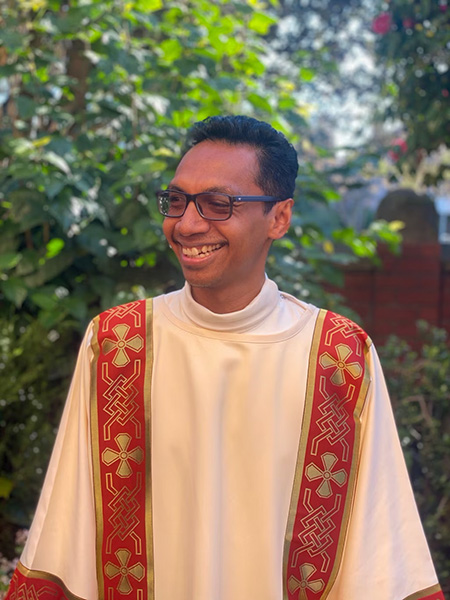 One of our Carmelite students, Anacleto Guterres da Costa, has recently been ordained as a Deacon. His journey began in heartbreak, with the loss of his family and his early years spent in an orphanage. Yet, through resilience and faith, Anacleto has defied the odds and is now well on his way to becoming a Carmelite priest.
One of our Carmelite students, Anacleto Guterres da Costa, has recently been ordained as a Deacon. His journey began in heartbreak, with the loss of his family and his early years spent in an orphanage. Yet, through resilience and faith, Anacleto has defied the odds and is now well on his way to becoming a Carmelite priest.
Reflecting on his experience, Anacleto shares:
“As I grew up, I learned to accept the reality of what happened to me, and step by step, I became aware that God has never abandoned me. In the orphanage, the Carmelite sisters loved me as if I were their son. They provided everything I needed throughout my childhood and guided me to become a good man. The Carmelites nurtured me, not just spiritually, but by their constant presence."
Thanks to the generosity of donors like you, young Timorese people like Anacleto have been given hope and a pathway to change their lives and serve their communities. Your support enables us to train the next generation of Carmelite priests, who will go on to serve in Timor-Leste, Australia, and around the world.
“My dream is to be a priest, also to be a Carmelite Priest. This is my dream. Since I was in the orphanage, although I was still young, I remember I said, 'One day I will be the Pope and my brother will be a bishop!"
Br Anacleto Guterres da Costa, O.Carm
The Carmelites - Australia and East Timor
We support people from all walks of life who have suffered both emotional and physical loss. We empower them to embrace a fulfilling life for themselves, their neighbours and their communities.
In Australia we offer programs and services which help people facing social, economic and life challenges. Through places of reflection such as the Carmelite Library, Carmelite Centre and Sancta Sophia Retreat Centre we offer people pastoral care helping to restore their faith.
In East Timor we work alongside people both in spiritual and practical ways to help overcome past hurt, restore dignity and bring them out of poverty. Through friendships formed we empower the Timorese people to rebuild their communities.
To make a donation please contact:
Fundraising Development
The Carmelites Australia & Timor-Leste
75 Wright Street, Middle Park VIC 3206
Phone:+61 3 9690 8822
E-mail: This email address is being protected from spambots. You need JavaScript enabled to view it.
Read our Privacy Statement here
Carmelite Formation Fund
Our East Timorese and Australian students are at various stages of their Carmelite education. Each student has made a deep and personal commitment to study to become a Carmelite priest or brother. With your help these Carmelite formation students will make a valuable difference to their communities and to the people of East Timor and Australia. It costs $50,000 a year to feed, clothe, house and educate a young Carmelite student in Australia.
Become an East Timor Mission Partner
You can become an East Timor Mission Partner bringing hope and freedom to the people of East Timor.
You can help transform the lives of people like Gloria, Lucinda and Sabino by providing health care, food, clothing, books and an education.
Sabino
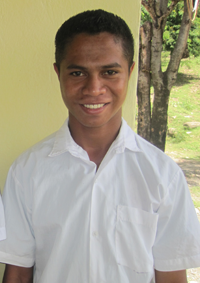 Sabino, 20, is in Year 12 at high school in Zumalai. He lives in the Carmelite boarding house – here he has a place to live and study, food to eat, school books and uniform. Sabino wants to study English and computer skills when he finishes high school.
Sabino, 20, is in Year 12 at high school in Zumalai. He lives in the Carmelite boarding house – here he has a place to live and study, food to eat, school books and uniform. Sabino wants to study English and computer skills when he finishes high school.
"The Carmelites teach us to pay attention to our studies and show us we need to be grateful for this experience by praying to God and sharing in daily prayer with the Carmelites' he says. He doesn't want to fail.
Sabino is very aware that as the oldest male in his family (his father died in 2009) he must study hard so he can get a good job to look after his mother, 10 brothers and sisters.
To make a donation please contact:
Fundraising Development
The Carmelites Australia & Timor-Leste
75 Wright Street, Middle Park VIC 3206
Phone:+61 3 9690 8822
E-mail: This email address is being protected from spambots. You need JavaScript enabled to view it.
Read our Privacy Statement here
 Remember The Carmelites in your Will
Remember The Carmelites in your Will
Leaving a Gift in your Will is a personal choice of great importance. It’s a generous gesture that will reflect your faith, beliefs and values well into the future.
By leaving a gift to The Carmelites in your Will, your legacy can create a future of possibilities. Whether it is training young men to become priests, and equipping them to become leaders of their communities, or providing young Timorese people with hope for a better future through education, your gift will sustain our work and transform lives.
To find out more about leaving a gift in your Will to The Carmelites pdf download our Gifts in Wills booklet.
You can also contact us on 03 9690 8822 or at This email address is being protected from spambots. You need JavaScript enabled to view it..
Carmelite Prayer Cards
A selection of prayer cards for different occasions is now available.
 These cards not only convey your care and concern for those in need. They also let you include those you love in the masses and prayers of the Carmelites.
These cards not only convey your care and concern for those in need. They also let you include those you love in the masses and prayers of the Carmelites.
Cards are available for:
- sympathy for those who have lost a loved one
- healing & peace for those who are ill
- spiritual support for those in physical or emotional stress
- special occasions such as birthdays and anniversaries
- prayerful wishes for any occasion
Together we can engage lives, restore people’s faith
and transform communities.
Help us bring HOPE to the lives of people who need it the most both in Australia and East Timor. Together we can engage lives, restore people’s faith and transform communities.
Help children get the best start in life.
Give HOPE to the Children of East Timor.
Together we have the opportunity to make a difference to young East Timorese children and empower them with something most of us take for granted … an EDUCATION and a chance to finally break the cycle of poverty.
With over 8,400 young people under the age of 17. In Zumalai our education programs will help stop children falling through the cracks. Your gift will give HOPE and FREEDOM to the Children of Zumalai, East Timor through these projects:
- Building three new classrooms at a village primary school to cater for increased demand.
- Erecting a new boarding house to accommodate 15-20 children from outlying villages so they can attend school.
- Providing 10 Tertiary Scholarships so young adults can attend technical college or university in Dili and Indonesia.
We need to raise $130,000 to funds these projects. Help children achieve their dreams and change the course of their lives by equipping them with a sound foundation.
To make a donation please contact:
Fundraising Development
The Carmelites Australia & Timor-Leste
75 Wright Street, Middle Park VIC 3206
Phone:+61 3 9690 8822
E-mail: This email address is being protected from spambots. You need JavaScript enabled to view it.
Read our Privacy Statement here
https://carmelites.org.au/itemlist/user/63-d41d8cd98f00b204e9800998ecf8427e?start=150#sigProIdd01b1f7c3d
Christmas prayers & greetings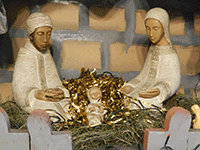
December 2014
We send our prayers and best wishes for a very happy Christmas to all the members of the Carmelite Family in Australia and Timor Leste.
As always, you will be remembered at Midnight Mass at the National Shrine of Our Lady of Mount Carmel, Middle Park, Vic.
We remember those victims of the recent tragedies in Sydney and Cairns – they and their families will be in our thoughts and prayers this Christmas, too.
Our New Novices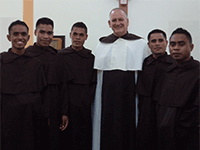
December 2014
Our new novices, Estevão Mendonça De Jesus, Luis Baptista, Francisco Xavirius Vieira Martins, Luis Mendonça Maia and Estevão De Deus Gomes were received into the Novitiate on Sunday 14 December. Fr Bruce Clark (Regional Prior & Novice Master) was the celebrant.
As well as the Carmelites present, over 120 members of the new novices' families attended. The ceremony was followed by morning tea with time for the families to see our house. After lunch there was some traditional tebe-tebe (dance). Some families came quite a distance - at least 4 hours on the back of trucks and faced the prospect of going home in heavy rain.
We warmly welcome our new brothers and congratulate them on taking this step on their Carmelite journey.
The Vine – Latest issue now available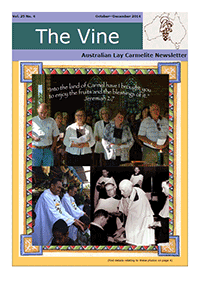
December 2014
In this issue:
• Fr Paul Gurr sees signs of growth among the Lay Carmelites
• Christine Wade reflects on Advent and the work of LCNC
• Part 1 of Sr Paula’s reflection on St Teresa of Avila
• Lay Carmelite celebrations in Rockhampton
• Keith Belton reflects on his visit to Timor Leste for the Ordinations
• 50 years of Carmel on the Central Coast
• Lay Carmelite Bookshop news
![]() The Vine 25.4 December 2014 (1.81 MB)
The Vine 25.4 December 2014 (1.81 MB)
St Teresa of Avila's Walking Staff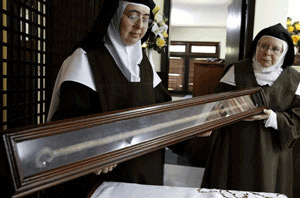
December 2014
The original walking cane used by St Teresa of Avila during her journeys across 16th Century Spain arrived at the Discalced Carmelite Friars' priory in Varroville, NSW as part of a global "Way of Light" pilgrimage to mark the 500th anniversary of her birth.
Read more ...
Magnificat newsletter - NEW!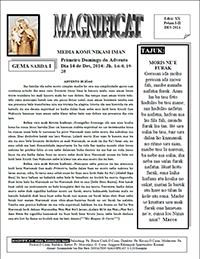
December 2014
Our young Carmelite students in Hera, Timor Leste write and publish a newsletter of Carmelite spirituality and reflection twice a month.
Under the guidance of Fr Paskalis, the 4 page newsletter features articles about Carmelite saints and topics as well as reflections on the Seasons of the Year and the Sunday Scripture. Articles are written in Tetum, Portuguese and Indonesian.
Next year we hope to be able to offer some excerpts from Magnificat in English for you.
![]() Magnificat Advent 2 2014 (775.35 kB)
Magnificat Advent 2 2014 (775.35 kB)
Carmelite Superiors meet in Vietnam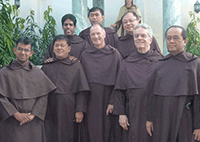
December 2014
Carmelite superiors from the Asia-Australia-Oceania region met in Ho Chi Minh City, Vietnam from 3-7 November. Present were Frs Benny Phang (General Councillor for the Region), Mario Esposito, (Provincial, St Elias) and Stephen Tuu Le (local superior, Vietnam), Ignatius Joko Purmomo (Provincial, Indonesia), Kuriakose Chandanaparambil (General Delegate India), Robert Puthussery (Provincial, India), Christian Buenafe (Provincial, Philippines), and Denis Andrew, (Provincial, Australia & Timor Leste).
There was a general sharing of information about Carmelite life in the various parts of the Region which has some 680 professed Carmelites. Among the issues discussed were the Global Plan of the General Council 2013 -2019 and mutual support for the leaders of the Region. ASOCINE will continue as a bi-monthly e-magazine of Carmelite News in the Region. Fr Benny Phang will make a fraternal visitation of the Province from 10 to 20 August 2015.
Australia's new Zimbabwean connection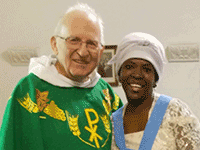
December 2014
In 1956 three Carmelites from Australia, Fr William Morganti, Fr Robert Dowd and Br George Parsons travelled to Rhodesia (now called Zimbabwe) to work with the Irish Carmelites in their mission for the next 7 years.
Our Zimbabwean connection has recently been renewed when Fr Jim Des Lauriers was asked to be Chaplain to the Zimbabwean community in Victoria.
In October 2013 Zimbabwean Catholics gathered in Perth for a congress attended by Fr Constantine Masarira, OCarm who travelled from Zimbabwe to attend.
More story & photos
JPIC Newsletter - December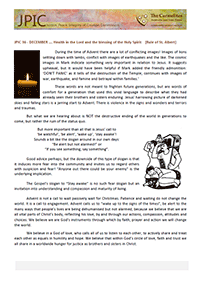
December 2014
Now available for you to download.
In this issue
- Advent reflection
- Elimination of Violence Against Women
- Intercessions
- Carmelite Tradition - the Carmelite NGO
- Blessing When the World is Ending
- JPIC Websites
![]() JPIC December 2014 (524.15 kB)
JPIC December 2014 (524.15 kB)
Lectio Divina for December - available NOW
December 2014
You can download and save the scripture texts, reflections and prayers for Lectio Divina for each day of this month by clicking the link at the end of this story. Available in pdf format or eBook (for your iPhone/iPad) or your Kindle.
Lectio Divina is a traditional way of praying the Scriptures so that the Word of God may penetrate our hearts and that we may grow in an intimate relationship with the Lord.
It is a very natural way of prayer and was developed and practised by the early monks and so came to the first Carmelite hermits. Visit our Lectio Divina page. These texts are prepared by a group of international Carmelites to help all those who use the Lectio Divina method of praying with the scriptures.
![]() Lectio Divina December 2014 PDF (871.46 kB) |
Lectio Divina December 2014 PDF (871.46 kB) | ![]() Lectio Divina December 2014 iPhone/iPad (407.12 kB) |
Lectio Divina December 2014 iPhone/iPad (407.12 kB) | ![]() Lectio Divina December 2014 Kindle (519.54 kB)
Lectio Divina December 2014 Kindle (519.54 kB)
New video from the Carmelites in Hera, Timor Leste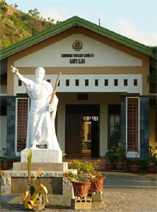
November 2014
Thanks to our young Carmelites in Hera, Fiona Matthews (Whitefriars College) and Sue Stuckey you can get a glimpse of life in the Carmelite community at Hera in a new video.
Sue also visited Timor Leste recently helping our students continue their study of English.
You can read Sue's story and watch the video here.
Carmelite Pilgrimage attracts record number of participants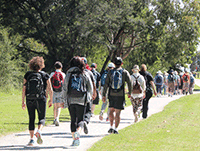
November 2014
This year's Carmelite Pilgrimage attracted 37 participants including 7 teachers from Brisbane Catholic schools.
The 40km Pilgrimage led by Fr Wayne Stanhope (Director of Formation) took place from 7-10 November in the beautiful Yarra Valley. Along with other pilgrims the Leadership Team of St Ignatius' College, Toowong, the APRE from Southern Cross College, Scarborough and a Project Office from Brisbane Catholic Education Office travelled from Melbourne to Lilydale to begin their trek to Mt Evelyn.
Read the full story and watch the video
Regional Formators meet in The Philippines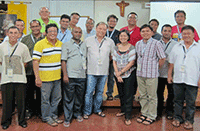
November 2014
This week Carmelite formators in our Asia-Australia-Oceania Region of the Order are meeting in Manila.
The meeting organised by the International Formation Commission is being held at the Institute of Formation for Religious Studies and includes some 15 formators of the Region (The Philippines, Vietnam, India, Indonesia, Australia, Timor Leste) including Fr Wayne Stanhope (Director of Formation, Australia and Timor Leste) and Fr Krisna Adjningraha (one of the formators in Timor Leste).
Read more
2015 Carmelite Liturgical Guide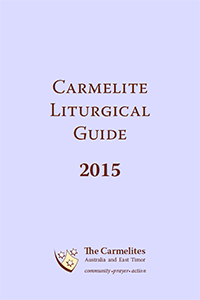
November 2015
Carmelite Communications has published the 2015 Carmelite Liturgical Guide.
The Guide lists the various Carmelite solemnities, feasts and memorials as well as the usual liturgical celebrations of the Roman Calendar. The Guide is an indispensable help to those wishing to celebrate Mass and the Prayer of the Church according to the Carmelite Calendar.
The hard copy version has been designed to fit inside the cover of your Breviary.
In the online version below you can use the "Bookmarks" to quickly choose the current month.
You can download the Guide here: ![]() 2015 Carmelite Liturgical Guide (138.13 kB)
2015 Carmelite Liturgical Guide (138.13 kB)
Benefit Concert for Timor Leste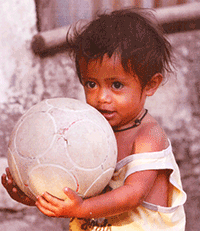 7.30pm Saturday 15 November
7.30pm Saturday 15 November
November 2014
Whitefriars College Theatre, 156 Park Road, Donvale, Vic. Featuring Joshua Bridge, Brenna Wee, Joey Cirillo, Baily Sampson, Jareen Wee, Chelsea Elder, Cathryn Young, and Naomi Bridge. Tickets: $20, Students $15.
Come along for a wonderful night of entertainment with all proceeds going towards educations opportunities for the people of Timor Leste. For tickets contact This email address is being protected from spambots. You need JavaScript enabled to view it. on 9872 8238 or This email address is being protected from spambots. You need JavaScript enabled to view it..
Last chance for tickets in the Carmelite Raffle which will be drawn at the concert.
Win a holiday for 8 people for 4 nights at the Hunter Valley Lodge valued at $4,500 including $500 towards flights - courtesy of Helping Hand Group and Freedman & Turner Travel Associates. All proceeds to our Education=Freedom programs for East Timor.
Phone (03) 9690 8822 by Thursday for your tickets. Don't miss out!
JPIC Newsletter - November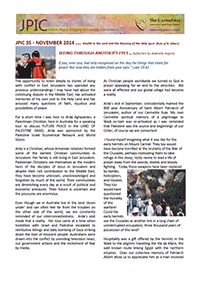
November 2014
Now available for you to download.
In this issue
- Seeing through another's eyes
- JPIC Calendar for November
- Prayerful Reflection
- Declaration of the Rights of the Child
- JPIC Websites
![]() JPIC November 2014 (979.41 kB)
JPIC November 2014 (979.41 kB)
Lectio Divina for November - available NOW
November 2014
You can download and save the scripture texts, reflections and prayers for Lectio Divina for each day of this month by clicking the link at the end of this story. Available in pdf format or eBook (for your iPhone/iPad) or your Kindle.
Lectio Divina is a traditional way of praying the Scriptures so that the Word of God may penetrate our hearts and that we may grow in an intimate relationship with the Lord.
It is a very natural way of prayer and was developed and practised by the early monks and so came to the first Carmelite hermits. Visit our Lectio Divina page. These texts are prepared by a group of international Carmelites to help all those who use the Lectio Divina method of praying with the scriptures.
![]() Lectio Divina November 2014 PDF (818.42 kB) |
Lectio Divina November 2014 PDF (818.42 kB) | ![]() Lectio Divina November 2014 iPhone/iPad (361.72 kB) |
Lectio Divina November 2014 iPhone/iPad (361.72 kB) | ![]() Lectio Divina November 2014 Kindle (404.5 kB)
Lectio Divina November 2014 Kindle (404.5 kB)
New Lay Carmelite Community Council for Coorparoo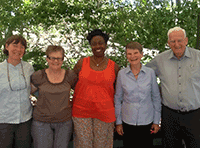
November 2014
Coorparoo Lay Carmelite Community met recently to elect a new Community Council. Members of the new Council are (left to right): Jennifer Porcellini, Joy Darby, Oby Emechite, Carmel Weston (Prior), together with Fr Matthew McPhee, OCarm., community chaplain.
Earlier in the year Ursula McNab and Joan Brady celebrated the 10th anniversary of their Final Profession as Lay Carmelites and the community gathered in September for a retreat on 'Carmelites: Mystics, Prophets and Servants' led by Fr Anthony Scerri, OCarm. About 50 people attended.
New E Bulletin for Carmelite Laity & Youth launched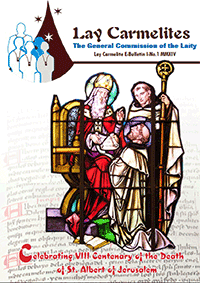
October 2014
This initiative is the result of the first meeting of the new General Commission for the Carmelite Laity and Youth of our Order. The Commission wants to strengthen spiritual formation and communications over the next 6 years. It hopes that the E Bulletin will prove to be a good way to learn more about our charism and spirituality, as well as the various projects of the laity and youth in different parts of the world.
This first issue highlights St Albert of Jerusalem and includes Lay Carmelite and Carmelite Youth news from around the world, including Australia.
Comments, suggestions and contributions for future issues are welcome. Any news regarding Lay Carmelites and Carmelite Youth, please send to This email address is being protected from spambots. You need JavaScript enabled to view it..
![]() Lay Carmelite E Bulletin No 1 2014 (808.85 kB)
Lay Carmelite E Bulletin No 1 2014 (808.85 kB)
One Page - Extra - Latest issue now available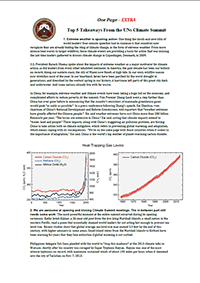
October 2014
This special issue is about the recent UN Climate Summit. Carmelite Eduardo Scarel, noted climate scientist, represented the Carmelite NGO at the Summit.
Top 5 Takeaways from the UN Climate Summit:
- Extreme weather is spurring action
- We are awesome at opening & closing Climate Summit meetings. The in-between part still needs some work
- The Green Climate Fund
- Private companies and cities are in the lead now
- We might actually keep forests around for a bit longer
![]() One Page Extra - October 2014 (194.63 kB)
One Page Extra - October 2014 (194.63 kB)
Visit our Justice, Peace & Integrity of Creation page
Ever wondered what the Carmelite NGO is?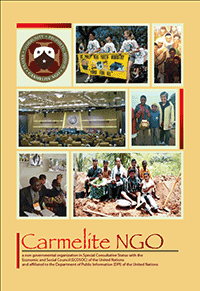
October 2014
The Carmelite NGO gives the worldwide Carmelite Family a voice in global issues at the United Nations. Founded in 2001 the Carmelite NGO assists members of the Carmelite Family in advocating on important global issues such as education, freedom of belief, human rights and sustainable development.
The goal of the Carmelite NGO is to actively participate in creating a more peaceful, just and loving world by advocating and caring for the spiritual and human needs of the human family and the environment. To accomplish this, we have chosen to actively participate at all levels of decision making-- from the individual deciding what affects him or herself and family to those decisions which affect the world. The Carmelite NGO is one means to accomplish this.
![]() CarmeliteNGO Booklet (1.57 MB)
CarmeliteNGO Booklet (1.57 MB)
Visit our Justice, Peace & Integrity of Creation page
Pope Francis on Teresa of Jesus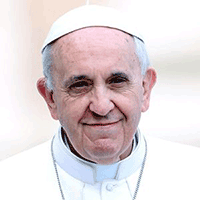
October 2014
In a message to Bishop Jesus Garcia Burillo of Avila Pope Francis mentions the joy the saint often spoke of “in encountering the suffering of work and pain”, and how she affirmed that “the Gospel is not a bag of lead that trails heavily behind us, but rather a source of joy that leads the heart to God and urges us to serve our brethren”.
St Teresa emphasised the importance of cheerful perseverance and prayer. For her, contemplative prayer was “a close sharing between friends; … taking time frequently to be alone with him who we know loves us”.
The Pope remarks that this advice is “perennially valid”. “Teresa of Jesus recommended three things: to love each other, to free each other, to free oneself of everything, and to aspire to true humility”.
“It is this Teresian realism”, writes the Pope, “that demands works instead of emotions, love in the place of dreams, and the realism of humble love instead of eager asceticism”. He concludes, “Let us hope that everyone may be infused by this holy impulse to travel the roads of our own time, with the Gospel in our hand and the Spirit in our heart!”.
Read the full text of Pope Francis' letter.
15 October - Feast of St Teresa of Jesus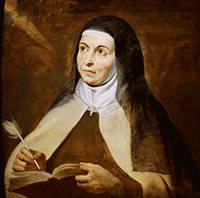
October 2014
Today is the feast day of St Teresa of Jesus (Avila). 28 March next year (2015) will be the 500th anniversary of her birth in Avila, Spain. She entered the Carmelites and made great progress in the way of perfection and was granted mystical revelations. Wishing to share in the spiritual renewal of the Church of her time, she began to live her religious life more ardently and soon attracted many companions.
Teresa also helped in the reform of the friars with Saint John of the Cross. She wrote books which are renowned for their depth of doctrine and which showed her own spiritual experiences. She died at Alba de Tormes in 1582. In 1970 Teresa was declared a Doctor of the Church by Pope Paul VI.
The Vine - Latest issue now available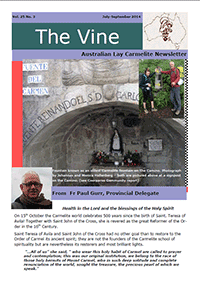
October 2014
In this issue:
- Fr Paul Gurr reflects on St Teresa of Jesus
- Christine Wade reports on the recent National Council meeting
- First meeting of the General Commission for Carmelite Laity
- Sylvia Lucas concludes her series about Lay Carmelite Life
- News from the communities
![]() The Vine 25.3 September 2014 (1.52 MB)
The Vine 25.3 September 2014 (1.52 MB)
Whitefriars College staff & students visit Timor Leste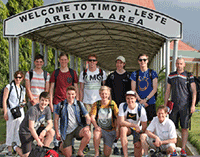
October 2014
On Monday 15 September nine Year 11 students, along with five staff members, boarded a plane for Dili, Timor-Leste for a ten day adventure.
Even though Timor-Leste is Australia’s closest foreign neighbour, the cultural change between the two countries is significant. Wide paved roads of Australia are replaced with dust covered, pot hole ridden chaos. Motor bikes are everywhere and people drive with the sound of a horn and by pushing their way into spaces that are barely apparent. Lanes are not defined nor is the flow of traffic. There are a few traffic lights now in Dili, but for the most part it is dodgem car courage as people weave their way toward their destination. One common sight is a family of four or more on one motor bike. Mum and dad will be wearing helmets to comply with the law, but none of the children will be wearing one.
Carmel Contact - latest issue now available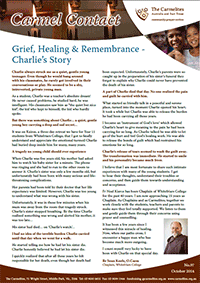
October 2014
In this issue
- Grief, Healing & Remembrance - Charlie's story
- Life's Journey through Spiritual Direction
- Fundraising for East Timor around Australia
- Ordination of Frs Angelino and Martinho
- McCorkell Constructions bring our projects to life
- Last chance for Hunter Valley Lodge raffle
- Special Gifts for Christmas
- Celebrating family, community and diversity
![]() Carmel Contact No 97 (344.78 kB)
Carmel Contact No 97 (344.78 kB)
Remembering those in God's care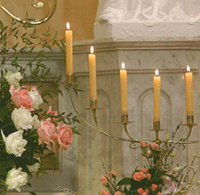
October 2014
Each year The Carmelites hold a special Mass of Remembrance as an opportunity to remember, give thanks and pray for those who are now in God’s care.
It is also an opportunity to draw strength from each other as we gently continue the journey of entrusting our loved ones into God’s care.
During the Mass you will be invited to light a candle in memory of your deceased relatives and friends and to place it near the altar.
This year's Mass will be celebrated at 6.00pm on Saturday 1 November in the National Shrine of Our Lady of Mount Carmel, Middle Park. You are warmly invited to attend.
CITOC Magazine - latest issue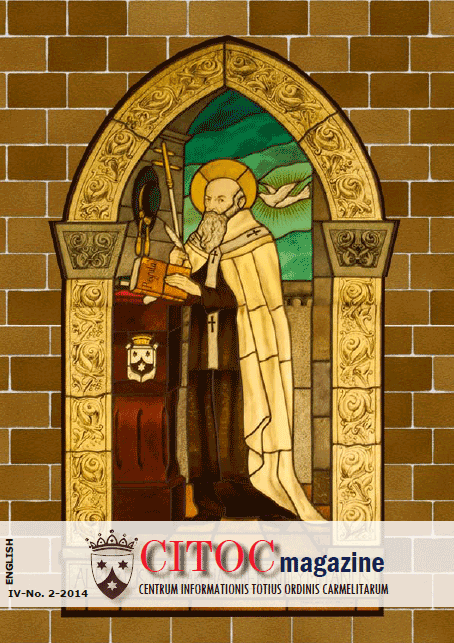
October 2014
The International Carmelite Communications Centre has published the second issue of CITOC Magazine for 2014.
In this issue
- Living the Carmelite Rule in our context
- 800th anniversary of death of St Albert of Jerusalem
- Carmelite Rule in the light of Vatican II
- 125th Anniversary of the arrival of the Carmelites in New York
- 25th Anniversary of JuCar (Carmelite Youth Movement)
- Carmelite Presence in Aragon, Castile & Valencia
- 25 years of Carmelite presence in France
- Golden Jubilee of 3rd Order in Kenya
and more. Click the link below to read more.
pdf CITOC Magazine No 2 2014 (1.57 MB)
Searching for Peace & Justice in the Holy Land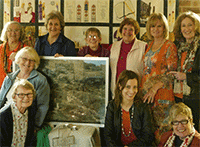
October 2014
Arda Aghazarian, a Palestinian peace activist, recently visited the Carmelite Spirituality Group at Jamberoo. In Australia at the invitation of World Vision and the Palestine Israel Ecumenical Network, Arda is an Armenian Christian living in Jerusalem.
Arda highlighted the need to avoid the 'heavy energy' which can drag believers down into a hole of literalism which creates crevasses between peoples. Click the link below to read more.
![]() Searching for Peace and Justice in the Holy Land (266.44 kB).
Searching for Peace and Justice in the Holy Land (266.44 kB).
Generals call for action to save Wadi es-Siah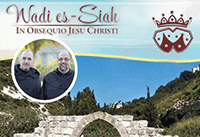
October 2014
Prior General, Fr Fernando Millán Romeral and Superior General, Fr Saverio Cannistrà have launched an appeal to raise funds for the restoration and maintenance of the ruins of the original monastery on Mount Carmel.
The Generals have called for a collection on 12 October in all Carmelite places to coincide with celebrations in Rome marking the 8th centenary of the death of St Albert of Jerusalem.
Visit www.wadi.info for more information and photos of the ruins.
![]() 2014 Letter of Generals about Ancient Carmelite Ruins (55.01 kB)
2014 Letter of Generals about Ancient Carmelite Ruins (55.01 kB)
![]() Wadi Fundraising Poster (325.19 kB)
Wadi Fundraising Poster (325.19 kB)
1 Page - Newsletter of the Carmelite NGO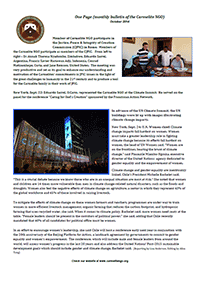
October 2014
The latest Carmelite NGO newsletter is now available.
In this issue:
- First meeting of International Carmelite JPIC Commission
- Eduardo Scarel represents Carmelite NGO at Climate Summit
- Role of Women in fighting Climate Change
![]() One Page October 2014 (413.87 kB)
One Page October 2014 (413.87 kB)
Feast of St Thérèse of Lisieux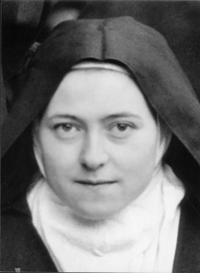
October 2014
October 1 is the feast day of St Thérèse of Lisieux. Popularly known as the "Little Flower", Thérèse Martin was born in 1873 in Alencon, France. At just 16 years old she entered the Discalced Carmelite Convent in Lisieux. Her sisters, Pauline and Marie also joined the Carmel at Lisieux.
Therese's autobiography, "Story of a Soul" contains her teaching on the 'way of confidence and love' which had great influence on the Church. Pope John Paul II proclaimed her a Doctor of the Church in 1997.
You can read more about St Therese and watch a short video here.
New priests celebrate Mass of Thanksgiving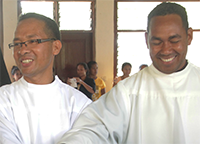
October 2014
Following their Ordination as priests on 30 August in Los Palos, East Timor, Fr Angelino and Fr Martinho each celebrated a Mass of Thanksgiving in their home villages.
Both Masses were celebrated with the customary colour and cultural elements common to celebrations in Timor Leste, and, of course, huge numbers of people attending and taking part.
Click here to view photos from the Masses of Thanksgiving.
New Chalice for Timor Leste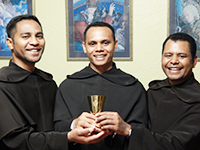
October 2014
The Little Flower Society of UK has donated a chalice to the Carmelite Mission in East Timor.
The Society recently sent out a mailing with small pieces of pewter attached to the letter. People were asked to return the small piece of pewter with their donation and then a chalice would be made from the pieces. This chalice would be used in one of the Carmelite missions around the world.
It was decided that the chalice should be used in the Carmelite Mission of East Timor and the chalice arrived in Australia in September on its way to East Timor. The chalice has the emblem of the Society of the Little Flower engraved on the front.
Picture shows East Timorese Carmelite students Agedo Bento, Januario Pinto and Martinho Lemos with the chalice which will be taken to East Timor in November.
More Ordination photos now available
October 2014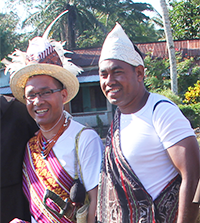
Fr Angelino Dos Santos and Fr Martinho Da Costa were ordained on 30 August in Los Palos, East Timor, by Bishop Basilio do Nascimento.
More photos from the colourful, outdoor Ordination Mass are now available for you to view.
Click here to see more photos from the Ordination of Angelino and Martinho.
Lectio Divina for October - available NOW
October 2014
You can download and save the scripture texts, reflections and prayers for Lectio Divina for each day of this month by clicking the link at the end of this story. Available in pdf format or eBook (for your iPhone/iPad) or your Kindle.
Lectio Divina is a traditional way of praying the Scriptures so that the Word of God may penetrate our hearts and that we may grow in an intimate relationship with the Lord.
It is a very natural way of prayer and was developed and practised by the early monks and so came to the first Carmelite hermits. Visit our Lectio Divina page. These texts are prepared by a group of international Carmelites to help all those who use the Lectio Divina method of praying with the scriptures.
![]() Lectio Divina October 2014 PDF (816.07 kB)|
Lectio Divina October 2014 PDF (816.07 kB)|![]() Lectio Divina October 2014 iPhone/iPad (326.98 kB) |
Lectio Divina October 2014 iPhone/iPad (326.98 kB) | ![]() Lectio Divina October 2014 Kindle (362.67 kB)
Lectio Divina October 2014 Kindle (362.67 kB)
Gerald O'Collins at The Carmelite Centre Melbourne - 7 October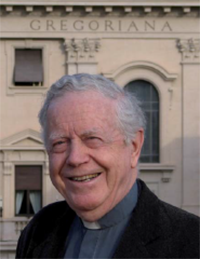
September 2014
Acclaimed theologian, biographer and autobiographer, Fr Gerald O'Collins SJ will give the 4th Carmelite Library Lecture for 2014 on Autobiography and Christianity.
Writing biographies has been a Christian activity since the beginning; witness the four Gospels. But what prompted greater and lesser Christian figures into writing autobiographies? Is producing an autobiography a worthy spiritual project?
![]() Gerald OCollins Library Lecture 2014 (54.2 kB)
Gerald OCollins Library Lecture 2014 (54.2 kB)
Tuesday 7 October 7.00-9.00pm at The Carmelite Centre 214 Richardson Street, Middle Park 3206.
More information & bookings: (03) 9690 5430 | This email address is being protected from spambots. You need JavaScript enabled to view it. | www.thecarmelitecentremelbourne.org
Catholic Media publish Ordination reports
September 2014
Pathways, the newsletter of Catholic Religious Australia, and Kairos News Service of Melbourne Archdiocese have published reports of the Ordination of Fr Angelino Dos Santos and Fr Martinho da Costa.
You can see the reports by clicking the links below.
Dempsey & Butler - Prominent Australian Catholics
September 2014
Lay Carmelites James Dempsey and John Butler have been accepted into Australia's Catholic 'Hall of Fame', Prominent Australian Catholics.
Appearing on the catholicaustralia.com.au website, Prominent Australian Catholics is a list of Catholics who have made significant contribution to Australian life. John Dempsey's name links to the Lay Carmelites in Botany Bay page on this website.
For the ten years between 1810 and 1820 Dempsey was virtually the centre of Catholic life in the colony. It was at his house that the Eucharist remained after the brief ministry of Fr Jeremiah O'Flynn in 1817.
Feast of St Albert of Jerusalem - 17 September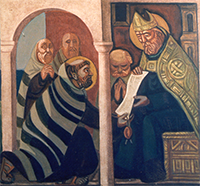 September 2014
September 2014
Albert was born in Emilia, Italy in the mid 12th century. He became a Canon Regular of the Holy Cross at Mortara (Pavia) where he was elected Prior in 1180. He was appointed Bishop of Bobbio in 1184 and of Vercelli the following year.
In 1205 he was elected Patriarch of Jerusalem and soon after nominated as papal legate for the ecclesiastical province of Jerusalem. He arrived in Palestine early in 1206, taking up residence at Acre, at the foot of Mount Carmel, as Jerusalem was occupied by the Saracens.
Sometime between 1206 and his death in 1214 Albert was approached by the Latin hermits on Mount Carmel for a 'formula of life' which later became the Carmelite Rule.
Teresa of Jesus: Listening to her story
September 2014 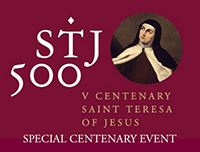
In following the progress of her life, her journey of transformation, we come to know the woman whose life inspires and encourages us on our journey.
Join our Spiritual Reading Group for this session about Teresa's life and journey of transformation lead by Adrian Jones.
![]() Teresa of Jesus: Listening to her story (67.21 kB)
Teresa of Jesus: Listening to her story (67.21 kB)
Tuesday 16 September 4.30-6.00pm at The Carmelite Library 214 Richardson Street, Middle Park 3206.
More information & bookings: (03) 9690 5430 | This email address is being protected from spambots. You need JavaScript enabled to view it. | www.thecarmelitecentremelbourne.org
Carmelite Way Pilgrimage Information Evening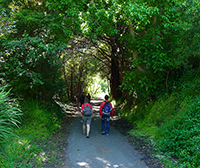 September 2014
September 2014
The annual Carmelite Way Pilgrimage will be held from Friday 7 to Sunday 9 November this year.
The Pilgrimage provides a uniquely Australian sacred experience of prayer and reflection through the Yarra Valley.
Join us at The Carmelite Centre for the Information Evening for all pilgrims
Wednesday 17 September 7.00-8.30pm at The Carmelite Centre, 214 Richardson Street, Middle Park 3206.
More information & bookings: (03) 9690 5430 | This email address is being protected from spambots. You need JavaScript enabled to view it. | www.thecarmelitecentremelbourne.org
5th Centenary of St Teresa of Jesus
September 2014
On 28 March 2015 we will celebrate the 500th anniversary of the birth of St Teresa of Jesus in Avila, Spain. The Carmelites of Australia and East Timor are developing a program of events throughout 2014 and 2015 to mark this important occasion.
You will see a logo like this on all events which are part of the Centenary program.
A First for Newly Ordained East Timorese Carmelites
September 2014
When Fr Angelino and Fr Martinho were ordained on 30 August in Los Palos, East Timor, they became the first East Timorese Carmelites to have done their entire Carmelite formation and preparation for priesthood after East Timor became part of the Australian Province in 2001.
They are also the first East Timorese Carmelites to complete their Carmelite formation and ministerial training in Australia. For the last 4 years they have been studying at ACU Melbourne, Yarra Theological Union, Box Hill and Melbourne University of Divinity.
Click here for more about the Ordination and photos.
Congratulations Angelino and Martinho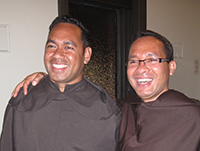
September 2014
Congratulations to our new priests: Fr Angelino Dos Santos and Fr Martinho Da Costa who were ordained yesterday by Bishop Basilio do Nascimento Martins in St Paul's Church, Los Palos, East Timor.
The ceremony was attend by some 5,000 people including 4 Carmelites from Australia: Fr Denis Andrew (Prior Provincial), Fr Bruce Clark (Regional Prior), Fr Wayne Stanhope (Director of Formation) and Fr James Des Lauriers (Prior of Middle Park Community).
More photos soon.
Lectio Divina for September - available NOW
September 2014
You can download and save the scripture texts, reflections and prayers for Lectio Divina for each day of this month by clicking the link at the end of this story. Available in pdf format or eBook (for your iPhone/iPad) or your Kindle.
Lectio Divina is a traditional way of praying the Scriptures so that the Word of God may penetrate our hearts and that we may grow in an intimate relationship with the Lord.
It is a very natural way of prayer and was developed and practised by the early monks and so came to the first Carmelite hermits. Visit our Lectio Divina page. These texts are prepared by a group of international Carmelites to help all those who use the Lectio Divina method of praying with the scriptures.
![]() Lectio Divina September 2014 PDF (717.55 kB) |
Lectio Divina September 2014 PDF (717.55 kB) | ![]() Lectio Divina September 2014 iPhone/iPad (367.01 kB) |
Lectio Divina September 2014 iPhone/iPad (367.01 kB) | ![]() Lectio Divina September 2014 Kindle (378.37 kB)
Lectio Divina September 2014 Kindle (378.37 kB)
Lay Carmelites - a growing family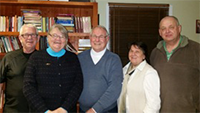
September 2014
Four Lay Carmelites from Wentworthville, Rockhampton and Central Coast communities are preparing to make their Solemn Profession this year. Melbourne community will receive three new members later this year and four more people are enquiring about becoming 'distant' members of the Lay Carmelites.
The Lay Carmelite National Council met on 22-24 August at the Benedictine Abbey, Jamberoo, to discuss the latest developments, focussing on formation for those just beginning their journey into Carmel.
During the meeting Fr Paul Gurr (Provincial Delegate for the Lay Carmelites) and Christine Wade (Moderator) reported on their visits to Rockhampton, New Zealand, Toowoomba, Adelaide, Central Coast and Wentworthville communities. Fr Paul and Fr Denis (Provincial) have also visited the ‘scattered’ Carmelites in Perth.
Coming up in September: Fr Anthony Scerri OCarm will join the Coorparoo Community for its retreat and Fr Paul and Christine will lead a retreat for the Melbourne Community. Fr Paul will also be visiting the Coorparoo community in October.
The LCNCA will meet again on 7-9 November.
JPIC Newsletter - September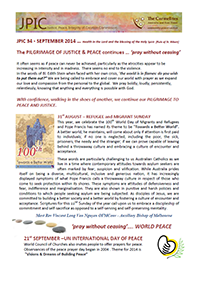
September 2014
Now available for you to download.
In this issue:
- Pilgrimage of Justice & Peace continues
- Refugee & Migrant Sunday
- International Day of Peace
- World Week for Peace in Palestine & Israel
- Reflections from Carmelite Tradition
Iconography and Prayer![]()
Discover a renewed appreciation of Iconography, an ancient art form used to help people pray and highlight spiritual qualities. The icon promotes a spiritual link between the human and divine. Today there is a resurgence of interest in Iconography – discover the reasons!
Join us at The Carmelite Centre as Sr Maria Moravski discusses this ancient art form which leads to prayer.
![]() Iconography and Prayer (59.98 kB)
Iconography and Prayer (59.98 kB)
Tuesday 9 September 7.00-9.00pm at The Carmelite Centre, 214 Richardson Street, Middle Park 3206. Cost: $25.00.
More information & bookings: (03) 9690 5430 | This email address is being protected from spambots. You need JavaScript enabled to view it. | www.thecarmelitecentremelbourne.org
College Students Raise $35,000 for East Timor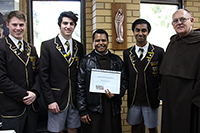
Students from Whitefriars College, Donvale (Vic) raised just on $35,000 to support the ministry of the Carmelites in East Timor. this year's Walk for Timor Leste also symbolises the College's growing link with the Timorese people and the Carmelite presence there.
College Captains Jared, Adrian and Dillon presented the cheque to Br Martinho Lemos, one of the East Timorese Carmelites studying in Melbourne. Also present was Fr Wayne Stanhope (Director of Formation).
Perth Lay Carmelites keep charism alive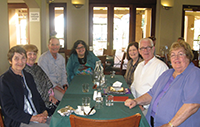
Carmelites join Prayer for Peace in Gaza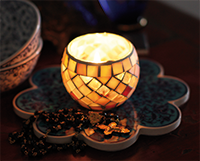
The Carmelites are joining with people throughout the world to pray for peace in Gaza.
(National Coalition of Christian Organizations in Palestine, July 2014)
Carmelites Launch Social media
The Carmelites of Australia and East Timor launched their social media presence on the Feast of St Mary of the Cross MacKillop, 8 August.
Our social media channels will be used to share our spirituality, news and information, to invite people into an experience of the Carmelite Way and to walk with them on their journey through life.
Our initial tweet anouncing our presence on social media has already been retweeted to 13,303 people.
Find us on Facebook. Follow us on Twitter.
East Timor Carmelites make Vows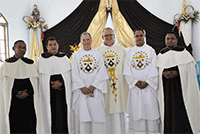
On 19 July Brs Calisto Cab Sila, Carlito Da Costa Araujo and Fausto Tilman De Araujo made their Solemn Profession (life-long commitment) as Carmelites during Mass at St Joseph's Church, Hera, East Timor.
During the same ceremony our 6 second year Novices made their initial commitment ....
Coorparoo Parish Raises funds for Timor Leste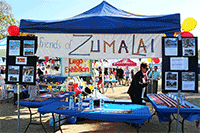
The Friends of Zumalai group in Our Lady of Mt Carmel Parish, Coorparoo (QLD), raised $662.00 selling bottled water at the Parish Primary School Community Fete.
The Fete, held on Sunday 3 August, attracts a large number of people and the warm weather helped the sales of water.
In addition to water the stall also sold $375 worth of tickets in the Carmelite Raffle raising money for the Carmelites' Education=Freedom program for the children of Zumalai Parish in East Timor.
Carmelites join Walk for Timor Leste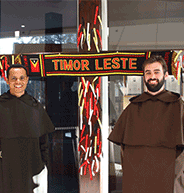
Br Januario Pinto and Br Matthew Tonini attended Mass on 18 July at Whitefriars College as part of the College's week-long celebration of the Feast of Our Lady of Mount Carmel.
Following the mass they joined Whitefriars College students in the annual Walk for Timor Leste to raise funds for the Carmelites' work in East Timor.
So far this year's Walk for Timor Leste has raised: $32,305.15.
JPIC Newsletter - August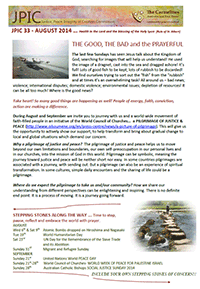
In this issue:
The good, the bad and the prayerful
August & September: Pilgrimage of Justice and peace
Our Carmelite Tradition & contemplative prayer
Embracing the world in contemplative prayer can take many forms
Young Carmelites renew their Vows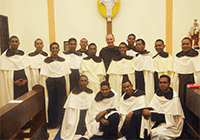
During July 18 young Carmelites in East Timor and Australia renewed their profession of vows for another year.
In East Timor 15 brothers made their renewal during Evening Prayer at the Carmelite Community in Hera (Dili) to Fr Denis Andrew (Prior Provincial).
In Australia Br Agedo Bento renewed his profession during Sunday Mass in the Carmelite parish of Our Lady of Mount Carmel, Coorparoo, QLD.
Brs J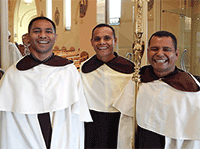 anuario Pinto and Martinho Lemos renewed their profession during Evening Prayer in the Carmelite Priory at Middle Park, Vic.
anuario Pinto and Martinho Lemos renewed their profession during Evening Prayer in the Carmelite Priory at Middle Park, Vic.
All these brothers are continuing their Carmelite formation and preparation for ministry in the Church.
We rejoice that these young men have decided to continue on the Carmelite Way and we are encouraged by their faith and commitment.
Carmelite Global Plan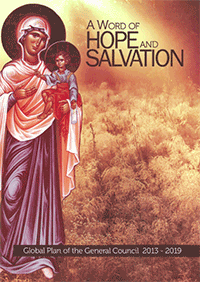
The General Council of the Carmelites has issued a global plan for the next six years.
Using the theme of the 2013 General Chapter, the General Council has called the plan, 'A Word of Hope and Salvation'.
"We live at a particular time in history when the Church is calling us anew to evangelisation… we wish to accept the challenges before us, offering to the world we live in “a word of hope and salvation”, the Council said.
Plans are offered for each of the geographical regions of the order: Africa, The Americas, Asia-Australia-Oceania and Europe. They are also offered for areas of special responsibility, including Communication, Evangelisation and Mission, Liturgy and Prayer, Finance, Formation, Justice, Peace and the Integrity of Creation, Laity, Carmelite Schools, Nuns and Sisters and for the revision of the 1995 Constitutions of the Order.
Lectio Divina for August
You can download and save the scripture texts, reflections and prayers for Lectio Divina for each day of this month by clicking the link at the end of this story. Available in pdf format or eBook (for your iPhone/iPad) or your Kindle.
Lectio Divina is a traditional way of praying the Scriptures so that the Word of God may penetrate our hearts and that we may grow in an intimate relationship with the Lord.
It is a very natural way of prayer and was developed and practised by the early monks and so came to the first Carmelite hermits. Visit our Lectio Divina page. These texts are prepared by a group of international Carmelites to help all those who use the Lectio Divina method of praying with the scriptures.
![]() Lectio Divina August 2014 PDF (780.32 kB) |
Lectio Divina August 2014 PDF (780.32 kB) | ![]() Lectio Divina August 2014 iPhone/iPad (415.58 kB) |
Lectio Divina August 2014 iPhone/iPad (415.58 kB) | ![]() Lectio Divina August 2014 Kindle (434.82 kB)
Lectio Divina August 2014 Kindle (434.82 kB)
Happy Feast Day - 16 July, Feast of Our lady of Mount Carmel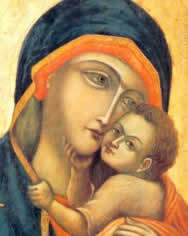
We wish all the members of our Carmelite Family a Happy Feast Day as we celebrate the Solemnity of Our Lady of Mount Carmel.
The early Carmelites on Mount Carmel dedicated their chapel to the memory of "St Mary" and claimed her as their own by adding "of Mount Carmel". They took her as their patroness, promising her their faithful service and expecting her protection and favour. They were proud to call themselves "Brothers of Saint Mary of Mount Carmel".
Following this ancient tradition, next Saturday Brs Carlito da Costa Araujo, Calisto Cab Sila and Fausto Tilman de Arajuo will make their Solemn Profession of Vows in Hera, Timor Leste. During the same mass Silveste Alves, Anacleto Guterres Da Costa, Jose Natalina Freitas, Frangelino Isaias Ximenes, Agustinho Da Conceicao Lobato Lourdes and Filomena Proto Oliveira Guterres will make their First Profession of Vows.
We hold them in our thoughts and prayers.
Coorparoo Parish celebrates Bl Peter To Rot with Papua New Guinea Catholic Community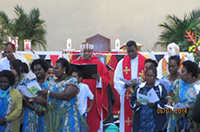
More than 80 members of the Papua New Guinea Catholic Community in Brisbane joined the Carmelite Parish of Coorparoo to celebrate the feast of Blessed Peter To Rot, the first Melanesian martyr to be beatified.
Members of the PNG Community led the music with traditional processions at the beginning of Mass, the Gospel and the Preparation of the Gifts. After mass the parish joined the community for light refreshments.
"Everyone left the church with a smile on their face," said Fr Paul Sireh (Parish Priest). he also said that the feast day would be celebrated every year in the parish with the PNG community.
Born around 1912, Blessed Peter To Rot was enrolled in 1930 at St Paul's College, Taliligap, which was founded by the Missionaries of the Sacred Heart for the formation of lay catechists. Three years later he was appointed catechist to the parish of Rakunai.
Read more about the life of Blessed Peter To Rot and see more pictures from the mass.
Lay Carmelite at Bishops' Conference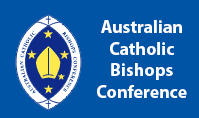
Chris Wade, Australian Lay Carmelite Moderator, attended the Australian Catholic Bishops' Conference annual national meeting of Catholic Lay Movements on 8 July at the Mary MacKillop Centre, North Sydney.
"I was keen to attend and meet other people involved in church life", Chris said, "however, my main motivation was to raise awareness of the Lay Carmelites and what we can contribute to the life of the church in Australia in the 21st century."
Each group gave a two minute thumbnail sketch of their group. These quick presentations were recorded for the Bishops’ further consideration. Bishop Peter Comensoli, Auxiliary Bishop in the Sydney Archdiocese attended, representing the Bishops Commission for Church Ministry.
"In my thumbnail presentation, I offered the Carmelite Way of contemplation based on prayer, community and service and emphasised stillness and silence as an antidote to the craziness of life in Australia today. In conclusion I quoted Ernest E Larkin OCarm, 'The goal of the Carmelite Order [is] to live continuously in the loving presence of God.'"
Shared Music brings healing and peace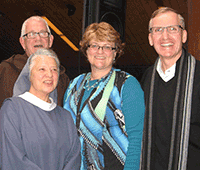
About 150 people gathered in the Albion Park Church, Wollongong, in response to the news that their local parish priest, Fr David Caterrall (40) has cancer.
David had asked Fr Paul Gurr OCarm and Sr Magdalen osb, along with local musician, Jen Charadia, to provide an evening of music for parishioners of his parish.
"I believe that shared musical experience is a healing and effective way for people to deal with the things they find difficult to grasp and manage," Fr Paul said.
This was certainly true at Albion Park where, together with their parish priest, David, the people laughed and cried, danced and sang along and strengthened their sense of family as they come to terms with Fr David’s illness.
We hold Fr David and his parishioners in our thoughts and prayers.
Poems of Doubt & Faith - from Tennyson & Arnold to Eliot
Join our spiritual reading group in the friendly atmosphere of the Carmelite Library. Max Richards will lead this session looking at Faith and Doubt in the poetry of Tennyson Arnold, Emily Dickinson, Hopkins, Hardy and Eliot.
![]() Poems of Faith And Doubt (142.5 kB)
Poems of Faith And Doubt (142.5 kB)
Tuesday 15 July 4.30-6.00pm at The Carmelite Centre, 214 Richardson Street, Middle Park 3206.
More information & bookings: (03) 9690 5430 | This email address is being protected from spambots. You need JavaScript enabled to view it. | www.thecarmelitecentremelbourne.org
Poetry for the Soul: Australian Spirituality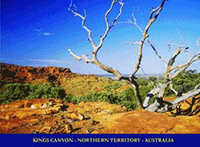
Looking at poems of great spiritual depth by Australian Poets: Les Murray, Kevin Hart, Francis Webb, Judith Wright, Rosemary Dobson—and many others.
Using these examples, Tony Kelly CSsR reflects on questions like: How can poetry refresh language? How does it refine our sensitivities to the whole range of reality? What is the spiritual and even Christian significance of poetry?
![]() Poetry for the Soul: Australian Spirituality (68.37 kB)
Poetry for the Soul: Australian Spirituality (68.37 kB)
Tuesday 22 July 6.30-8.30pm at The Carmelite Centre, 214 Richardson Street, Middle Park 3206.
More information & bookings: (03) 9690 5430 | This email address is being protected from spambots. You need JavaScript enabled to view it. | www.thecarmelitecentremelbourne.org
First Meeting of the General Commission for Carmelite Laity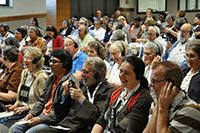
From 25 to 30 June 2014, Fr Désiré Unen, O.Carm. (Ita-Congo), Fr Joseph Hung, O.Carm. (SEL-Vietnam), Jennifer Wanjiku (Kenya), Normita Lacanilao (Philippines), José Araujo Filho (Brazil), Michele Bonanno (Italy), Juan Luis Laghi (Young People in Perú), María José García de la Barrera (Young People in Spain), gathered in Rome for the first meeting on the new Commission for Carmelite Laity under the leadership of Fr Raúl Maraví, O.Carm., Councillor General and President of this commission.
For five days the group worked on the content of the global plan for laity for the next 6 years and how to put it into effect. Each member was given an opportunity to talk about the experience of the situation of the laity and of young people in the different places where the Order is working, and the needs that exist in those places.
This work led the commission to form two sub-commissions, one for formation and the other for communication for the purpose of responding to the concerns and expectations of lay people on the international level.
It was also decided that an International Congress for Lay Carmelites be organised, to take place one year before the next General Chapter, as well as a series of other assemblies at a regional level. One of the objectives of the commission is to give more visibility and training to lay people who are part of the great Carmelite Family.
The Carmelite Laity in the Middle Ages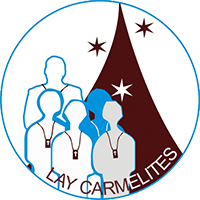
The foundation of the Mendicant Orders in the Middle Ages had a profound influence on the faithful — at that time the old monastic spirit flourished in the very midst of the people. Hence in this truly religious age, there were many who were attracted by the fervour of the Mendicants and wished to live according to the spirit of such Orders. But not all could embrace the religious life and indeed not all desired to do so.
The urgent need was a form of life which would enable the faithful to live in the world according to the spirit of religious life. Thus, the various religious, their own souls burning with love of God and love for their Orders, and anxious, too, that the devout faithful should also burn with the same love, organized a movement known as the Third Order.
Read more of this article by Australian Carmelite Fr James Pilkington, OCarm. (d. 1994)
Novena of Our Lady of Mount Carmel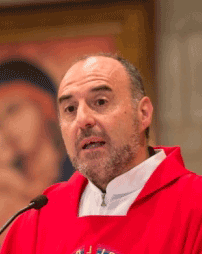
As the Feast of Our Lady of Mount Carmel is approaching, the Prior General has written a letter to the Carmelite family expressing his best wishes and inviting all members to celebrate the Feast, beginning with the Novena for the Feast of Our Lady of Mount Carmel from 7 to 15 of July 2014.
This custom of the Novena of Our Lady of Mount Carmel before the feast is a long tradition and is observed by many Catholics throughout the world.
In his letter the Prior General invites us to be united in contemplating, sharing, increasing the beauty which is all around us (even, if at times, somewhat hidden) because Carmel has been closely linked to beauty.
“My desire is that our lives should be a song of praise to God for the beauty that surrounds us, and also a generous commitment to ensure that beauty will not be diminished or tarnished by what is evil, by sin, by the suffering of so many innocent people, who are the victims of selfishness and all its ramifications, (injustice, violence, inequality .....).”
The Feast of Our Lady of Mount Carmel will be celebrated with a special Mothers' Mass at 10.30am on Sunday 20 July at the National Shrine of Our Lady of Mount Carmel, Middle Park.
Resources for National Aboriginal & Torres Strait Islander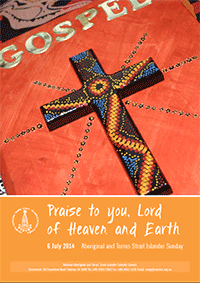
Sunday- 6 July
Visit our Justice, Peace and Integrity of Creation page to download resources for preparing for and celebrating NATSIC Sunday.
Resources include: Liturgy preparation, reflections, homily notes; activities for children and young people; prayer suggestions; personal stories; statistics and clip art.
Links to multimedia resources are also included.
The material is produced by the National Aboriginal & Torres Strait Islander Catholic Council.
![]() NATSICC Sunday Resources 2014 (1.71 MB)
NATSICC Sunday Resources 2014 (1.71 MB)
Also on our JPIC page
- Pope Francis on the Care of Creation -
 Creation 2014 (291.64 kB)
Creation 2014 (291.64 kB)
- Pope Francis on the Redistribution of Wealth -
 Wealth 2014 (132.17 kB)
Wealth 2014 (132.17 kB)
Farewell Angelino and Martinho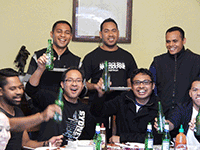
Our deacons, Angelino Dos Santos and Martinho Da Costa, were farewelled in a number of celebrations over the last weekend as they prepare to return to East Timor prior to their Ordination on 30 August.
Fellow East Timorese students gathered at the Carmelite Priory at Middle Park on Saturday 28 June for a BBQ lunch.
Parishioners of Port Melbourne/Middle Park Parish gathered at the 10.30am Mass on Sunday 29 to thank Angelino and Martinho for their ministry in the parish. Mass was followed by morning tea and the opportunity for parishioners to say their personal farewells. After Mass 15 Carmelites gathered at Middle Park Priory for a farewell lunch.
We wish Angelino and Martinho well as they return home to East Timor to continue their preparation for Ordination.
JPIC Newsletter - July 2014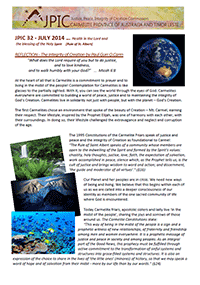
The June issue of our Justice, Peace & Integrity of Creation newsletter is now available for download.
In this issue:
- The Integrity of Creation - a reflection by Paul Gurr, OCarm
- July JPIC Calendar
- Good websites to visit
Visit our JPIC webpage for more including
- Pope Francis on the Care of Creation
 Creation 2014 (291.64 kB)
Creation 2014 (291.64 kB)
- National Aboriginal & Torres Strait Islander Sunday 2014
 NATSICC Sunday 2014 (1.71 MB)
NATSICC Sunday 2014 (1.71 MB)
- Pope Francis on the redistribution of Wealth
 Wealth 2014 (132.17 kB)
Wealth 2014 (132.17 kB)
Lectio Divina for July
You can download and save the scripture texts, reflections and prayers for Lectio Divina for each day of this month by clicking the link at the end of this story. Available in pdf format or eBook (for your iPhone/iPad) or your Kindle.
Lectio Divina is a traditional way of praying the Scriptures so that the Word of God may penetrate our hearts and that we may grow in an intimate relationship with the Lord.
It is a very natural way of prayer and was developed and practised by the early monks and so came to the first Carmelite hermits. Visit our Lectio Divina page. These texts are prepared by a group of international Carmelites to help all those who use the Lectio Divina method of praying with the scriptures.
![]() Lectio Divina July 2014 pdf (822.66 kB) |
Lectio Divina July 2014 pdf (822.66 kB) | ![]() Lectio Divina July 2014 iPhone/iPad (397.91 kB) |
Lectio Divina July 2014 iPhone/iPad (397.91 kB) | ![]() Lectio Divina July 2014 Kindle (411.78 kB)
Lectio Divina July 2014 Kindle (411.78 kB)
Matthew makes his First Profession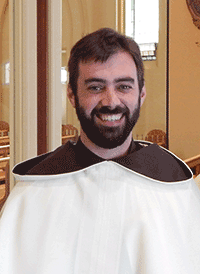 as a Carmelite
as a Carmelite
Br Matthew Tonini made his first profession of vows as a Carmelite on Sunday 22 June.
Matthew recently returned to Australia after completing his Novitiate at Brandsma Priory, Middletown, NY, USA.
Surrounded by his family, Carmelites from Australia and Timor Leste and parishioners Matthew made his profession during mass at the National Shrine of Our Lady of Mount Carmel.
Matthew, the eldest of 8 children, is a qualified teacher and holds an honours degree in Science.
The Vine - latest issue now available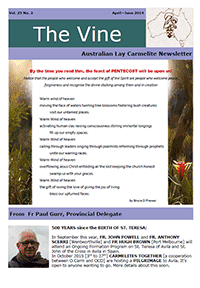
In this issue
- Pentecost Litany
- 5th Centenary of birth of St Teresa of Jesus (Avila)
- Meeting of new National Council
- Fr Paul and Chris Wade visit communities
- Local community news
- Living the charism & Mission of Carmel Today
- Jamberoo Community marches for peace
![]() The Vine 25.2 June 2014 (1.92 MB)
The Vine 25.2 June 2014 (1.92 MB)
New Lay Carmelite National Council meets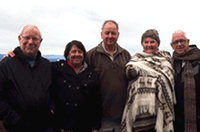
The new Lay Carmelite National Council of Australia met on the weekend of 2 – 4 May at the Benedictine Abbey, Jamberoo, amidst quiet solitude bedecked with stunningly beautiful Autumn leaves.
Council members are: Fr Paul Gurr (Provincial Delegate), Chris Wade (Moderator), Angela Zakarias (Secretary), Norm Harding (formator) and Ben Bekema (Treasurer).
During the meeting plans were made for visits to the New Zealand, Rockhampton, Wentworthville, Towoomba, Jamberoo and Adelaide.
Carmel Contact - latest issue now available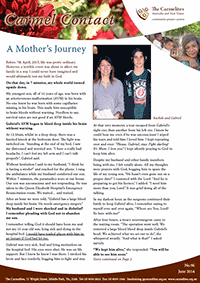
In this issue
- Rachele's Story - A Mother's Journey
- St Therese of Lisieux: An ordinary Saint
- Nine Days of Prayer for those in need
- message from the Prior Provincial
- Educating young Carmelites
- The Carmelites' Hunter Valley Raffle Prize
- East Timor Concerts
![]() Carmel Contact No 96 (819.68 kB)
Carmel Contact No 96 (819.68 kB)
Our new Deacons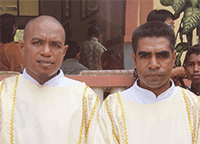
We warmly congratulate our new Deacons, Br Roque Soares Da Cruz and Br Carlito Da Silva on their ordination as Deacons on Pentecost Sunday, 8 June. The ceremony took place at the Diocesan Seminary Chapel at Nita on the island of Flores (Indonesia) where Roque and Carlito are completing their ministerial studies.
Carmel flourishes in Vietnam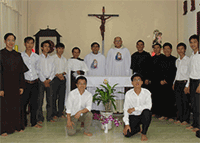
Fr Wayne Stanhope (Director of Formation) recently led a retreat for Br Paul and Br Francis, two young Carmelites preparing for Solemn Profession in Vietnam. The 30 day retreat was an immersion in the richness of the Carmelite Tradition. Paul and Francis will make their Solemn Profession in November this year.
There are 3 communities of Carmelites in Vietnam: Mount Carmel, where 6 brothers in First Profession live; St Therese, where 10 candidates for the Order live; and St Joseph's, the Pastoral house where 3 priests who minister to the people live.
Another 23 young men are in Vocational Accompaniment discerning their call to the Carmelite Way.
New pre-novices for the Province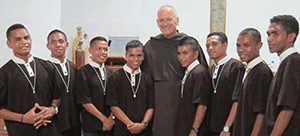
During Evening Prayer at Fatuhada community (Dili) on 4 May we formally welcomed into the pre-Novitiate 8 new candidates: Jacob Pereira dos Santos, Caitano Soares Da Silva, Jacob Dos Reis Carvalho, Francisco Soares Borges, Paulo Martins de Araújo, Jerónimo Nunes, Henrique da Conceicão and João Fernando Cabal.
All the Carmelites from Hera community were present as were some of the Hermanas Carmelitas sisters. Evening Prayer was followed by dinner and dancing. We wish these candidates a long and fruitful journey in Carmel.
Corsini House shows 'Faith in Action'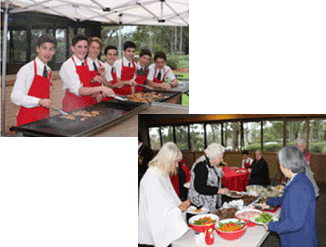
Corsini House at Whitefriars College has built a strong partnership with its charity, Doncare over the past 2 years. As well as providing financial support, more importantly we encourage students to show ‘Faith in Action’.
“On Tuesday, 27 May the Year 8s and Year 9s from Corsini 3 prepared a lunch for the elderly residents of Donvale. The event was a great
success as we prepared some delicious meals which were much appreciated by all the Doncare staff and guests that attended the event.
This was once again a great opportunity to help people who might not have otherwise had the chance to interact with us the younger
generation and this opportunity was much appreciated by all the boys.” Nick Dunmill (Year 9 C3)
St Teresa Centenary Pilgrimage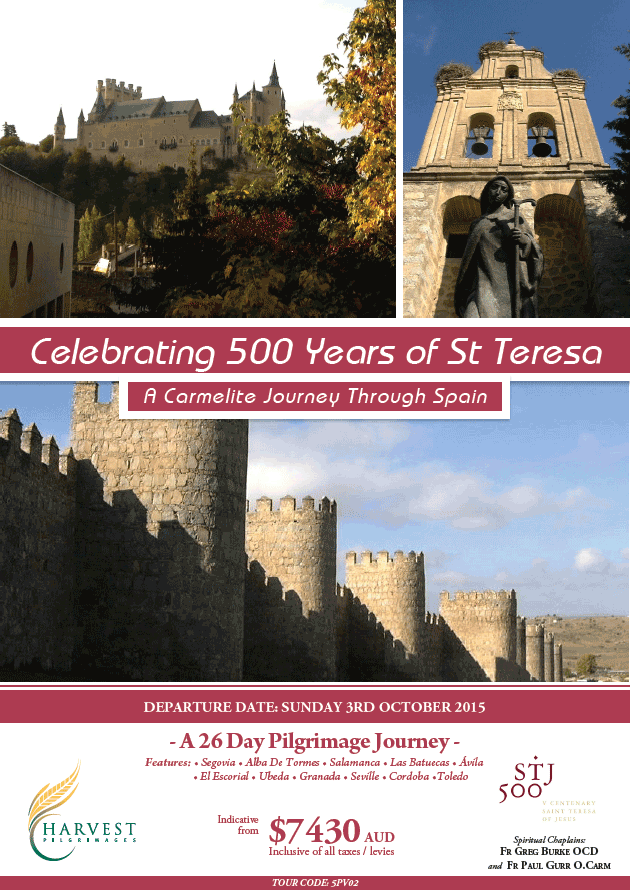
2015 marks the 500th anniversary of the birth of St Teresa of Jesus (Avila).
A special pilgrimage has been organised by Carmelites Together, an association of all the branches of the Carmelite Family in Australia.
Led by Fr Greg Burke OCD and Fr Paul Gurr OCarm this 26 day Carmelite journey through Spain will take you to Sergovia, Alba De Tormes, Salamanca, Las Batuecas, Avila, El Escorial, Ubeda, Granada, Seville, Cordoba and Toledo.
Bookings are now open for the pilgrimage which departs on Sunday 3 October 2015.
Click below to view the pilgrimage brochure and booking form.
![]() St Teresa Pilgrimage Brochure (1.99 MB) |
St Teresa Pilgrimage Brochure (1.99 MB) | ![]() St Teresa Pilgrimage Booking Form (214.56 kB)
St Teresa Pilgrimage Booking Form (214.56 kB)
Meeting of the International Formation Commission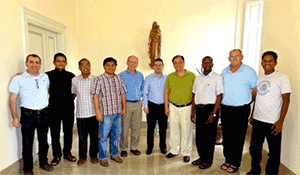
Members of the International Formation Commission met in Rome from 19 to 24 May 2014.
Those who attended were, Onesmus Muthoka (Ken), Krispinus Ginting (Indo), Jose Alex Valavanattu (Ind), Desiderio García (Arag), Wayne Stanhope (Aust), Noel Rosas (Phil), Quinn Conners (PCM), Albeiro Luis Romero (Ita-Col) and Giampiero Molinari (Ita), Benny Phang, General Councillor for Formation and Noel Rosas, Executive Secretary for Formation.
Among the items discussed were
- the main issues discussed by the International Formation Commission of the previous six years (2007-2013)
- the proposals approved at the General Chapter of 2013 in relation to formation (Secretary for formation and protocols for creating safe spaces for children and adults)
- the general plan of formation for the six years, 2013-19
- the 2013 RIVC, with a strategy for making known and having it studied throughout the Order
- suggestions for the revision of the Constitutions dealing with formation (Nos. 117-173)
- courses for the training of formation directors
- regional and international meetings for students, formation directors and ongoing formation
- the Ratio Studiorum
- translation of materials for the organization of the month of preparation for solemn profession
- revision of the Rite of Solemn Profession.
Compassion in the Workplace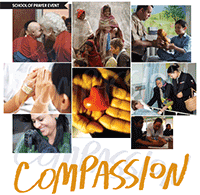
The practice of compassion is understood to be as important for health as physical exercise and healthy diet. Major universities around the world are now investigating and proving the importance of compassion, contemplation and meditation. In this forum, specific research outcomes from Stanford University and the Oxford Mindfulness Centre will be presented. This workshop is an exciting opportunity to not only hear about this research but more importantly to engage us in building a compassionate presence individually and in the workplace.
This event is hosted by the School of Prayer, a program of the Melbourne Archbishop’s Office for Evangelisation. The School of Prayer aims to provide information and resources promoting new and creative forms of meditative prayer suited to contemporary needs. Damien Peile from The Carmelite Centre Melbourne has contributed to planning this workshop.
Dr Lynne Reeder and Rev Dr John Dupuche will lead this session.
Thursday 19 June 9.30am-2.30pm at Thomas Carr Centre, East Melbourne.
![]() Compassion in the Workplace (363.49 kB)
Compassion in the Workplace (363.49 kB)
Lectio Divina for June
You can download and save the scripture texts, reflections and prayers for Lectio Divina for each day of this month by clicking the link at the end of this story. Available in pdf format or eBook (for your iPhone/iPad) or your Kindle.
Lectio Divina is a traditional way of praying the Scriptures so that the Word of God may penetrate our hearts and that we may grow in an intimate relationship with the Lord.
It is a very natural way of prayer and was developed and practised by the early monks and so came to the first Carmelite hermits. Visit our Lectio Divina page. These texts are prepared by a group of international Carmelites to help all those who use the Lectio Divina method of praying with the scriptures.
![]() Lectio Divina June 2014 pdf (880.5 kB) |
Lectio Divina June 2014 pdf (880.5 kB) | ![]() Lectio Divina June 2014 iPhone/iPad (515.71 kB) |
Lectio Divina June 2014 iPhone/iPad (515.71 kB) | ![]() Lectio Divina June 2014 Kindle (493.8 kB)
Lectio Divina June 2014 Kindle (493.8 kB)
Dante's Comedy in Images
The Spirituality of the Poem though the eyes of 20th century artists.
Join us at the Carmelite Centre for an exploration of the types of punishment in the Inferno, modes of penitence in the Purgatorio and varieties of spirituality in the Paradiso through text and images.
William Johnston, international historian and lecturer, will lead this fascinating session using several dozen 20th Century paintings relevant to specific scenes in Dante's Divine Comedy.
Tuesday 10 June from 7.00pm to 9.00pm at The Carmelite Centre, 214 Richardson Street, Middle Park 3206.
![]() Dantes Comedy in Images (93.51 kB)
Dantes Comedy in Images (93.51 kB)
More information & bookings: (03) 9690 5430 | This email address is being protected from spambots. You need JavaScript enabled to view it. | www.thecarmelitecentremelbourne.org
JPIC Newsletter - June 2014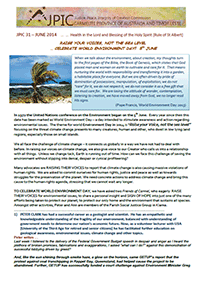
The June issue of our Justice, Peace & Integrity of Creation newsletter is now available for download.
In this issue:
- Raise your voices, not the sea level! World Environment Day 5 June
- June JPIC Calendar
- Good website to visit
- Justice for East Timor - maritime boundaries
- Prayerful Reflection
- Environmental Prayer
Visit our JPIC webpage for more
Our growing Carmelite Family
Over the next few months there will be quite a number of celebrations for our Carmelite Family.
The Provincial Council has announced the date for the Ordination to the Priesthood of Angelino Dos Santos and Martinho Da Costa which will take place on 30 August in Lospalos, Timor Leste.
Roque Soares da Cruz and Carlito da Silva are preparing for their ordination to the Diaconate in Flores on Pentecost Sunday, 8 June.
Matthew Tonini will make his First Profession of vows as a Carmelite on 22 June during Mass at 10.30am at the National Shrine of Our Lady of Mount Carmel, Middle Park, Victoria.
Carlito da Costa Araujo, Calisto Cab Sila and Fausto Tilman de Arajuo will make their Solemn Profession of Vows on 19 July in Hera, Timor Leste. During the same mass Silveste Alves, Anacleto Guterres Da Costa, Jose Natalina Freitas, Frangelino Isaias Ximenes, Agustinho Da Conceicao Lobato Lourdes and Filomena Proto Oliveira Guterres will make their First Profession of Vows.
Following these celebrations there will be 34 Solemnly Professed friars, 28 friars in First Profession, 3 Novices and 13 pre-novices in the Carmelite Province of Australia and Timor Leste.
We offer our prayer and congratulations to all these brothers marking significant steps on their Carmelite journey.
New on our Justice, Peace & Integrity of Creation page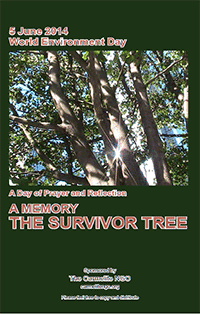
Take a look at our JPIC page where you'll find resources and articles on current Justice & Peace issues.
Recently added:
-
Prayers and Reflections for World Environment Day - 5 June 2014
-
Australian Catholic Bishops speak out for Asylum Seekers
-
Let's be good neighbours with Timor (Frank Brennan SJ)
-
The Spiritual Pathway to a Sustainable Environment (Eduardo Agosta Scarel, OCarm)
-
May Newsletter from our JPIC Commission
-
May Newsletter from the Carmelite NGO
Whitefriars Social Justice Focus
Whitefriars College students Chris Gozali, Hugh Vezey, Charles Dalziel and Michael Stringer (Social Justice Captain) attended the 2014 St Vincent De Paul College Conference recently.
During the conference each had the opportunity to take part in different sessions. Chris attended the session about the StVdP Soup Vans in Melbourne. "Soup vans are not just about the food, they are all about homeless people and their need for love."
At the session on homelessness Hugh learnt "that HOMElessness is not simply ROOFlessness. Homelessness refers to everyone that doesn’t have a place that they can feel safe in, have personal privacy in and a caring environment to live in".
Charles had the opportunity to learn about the homeless community in Melbourne. He discovered that they "are like a family, that they are extremely respectful of one another and that volunteering can be very personally rewarding and give you a feeling that is indescribable".
Michael learnt about "about society’s misconceptions about people that live on the dole and how a variety of different people end up on welfare. In fact, Australians on the dole are classified as living below the poverty line".
Michael said that "The Conference highlighted the variety of opportunities that we have to become more involved in helping those less fortunate than ourselves and we look forward to putting what we learnt into practice."
Carmelites contribute to YTU soccer win!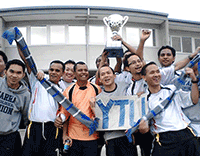
Brothers Angelino Dos Santos, Martinho Da Costa, Januario Pinto, Martinho Da Cruz Lemos and Agedo Bento were part of the winning Yarra Theological Union Soccer Team in the annual Brotherhood Cup held on 17 May.
Redemptorist, Divine Word Missionaries and Carmelite students made up the winning team. The opposing team was made up of Salesian, Dominican, Corpus Christi, Jesuit and MGL students.
The match was held at Salesian College, Chadstone, Victoria.
1 Page - Newsletter of the Carmelite NGO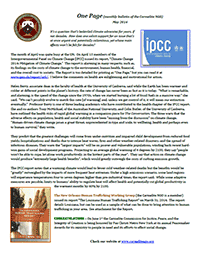
The latest Carmelite NGO newsletter is now available.
This issue deals with the 2014 report of the Intergovernmental Panel on Climate Change and the implications of global warming for food production, the healthy development of children, weather-related disasters and the spread of infectious diseases.
Also in this issue is information about a report on human trafficking in the state of Louisiana, USA.
On 1 June the Carmelite Commission for Justice, Peace, and the Integrity of Creation will be honoured by Pax Christi Metro New York at its annual Peacemaker Awards for its ministry to people in need and its efforts to effect social change.
Mass of Healing and Anointing 24 May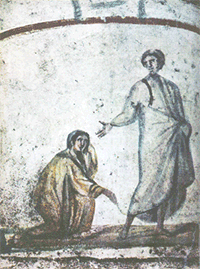
You are warmly welcome to join us for our Mass of Healing and Anointing on Saturday 24 May at 6.00pm at the National Shrine of Our Lady of Mount Carmel, Middle Park. This Mass is offered for all those in need of healing and peace in body, mind or spirit.
During the Mass everyone will be invited to receive the Sacrament of Anointing - a rite of anointing with Holy Oil and prayer for recovery.
“I was touched by your gentle Healing Mass, by the sense of peace and calm, by the tender touch of the priest as he anointed my forehead and hands – it was like God was actually touching me.”
You can send us the names of people you would like prayed for during the Mass of Healing and Anointing.
Further Information: (03) 9690 8822
Pathways Towards Meditation
For thousands of years meditation has been recognised for its remarkable benefits for body, mind and spirit. Join Meme McDonald for a nourishing day exploring techniques which will help you craft your own personal space and time for meditation.
Saturday 24 May 2014 10.00am-3.00pm at The Carmelite Centre, 214 Richardson Street, Middle Park 3206.
![]() Pathways Towards Meditation (47.63 kB)
Pathways Towards Meditation (47.63 kB)
More information & bookings: (03) 9690 5430 | This email address is being protected from spambots. You need JavaScript enabled to view it. | www.thecarmelitecentremelbourne.org
The Vine - Latest issue now available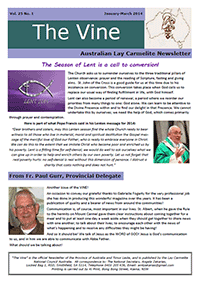
The Vine, the quarterly publication of the Australian Lay Carmelites is now available.
In this issue:
- Living the Charism and Mission of Carmel Today
- My Personal Lay Carmelite Journey
- New General Delegate for Carmelite Laity
- New in our Bookshop
- News from Communities
![]() The Vine 25.1 March 2014 (2.35 MB)
The Vine 25.1 March 2014 (2.35 MB)
Tips for Living Well: Learnings from Classical Psychology
Michael McGartland, Principal Clinical Psychologist at Alfred Health, and Anne Booth, Clinical Child Psychologist, explore the relationship of some classical studies in psychology with our experiences in everyday life.
Some questions which will be discussed are: How much are we influenced by our environment? What have we learnt from studies of infant-parent interactions? Is the child the parent of the adult? and How is it that good people can do bad things?
You are welcome to join us.
Wednesday 21 May 7.00pm-9.00pm at The Carmelite Centre 214 Richardson Street, Middle Park 3206
![]() Tips for Living Well (48.79 kB)
Tips for Living Well (48.79 kB)
More information & bookings: (03) 9690 5430 | This email address is being protected from spambots. You need JavaScript enabled to view it. | www.thecarmelitecentremelbourne.org
Roses for Mothers' Day
At Mount Carmel Parish, Coorparoo (Qld) parishioners are being invited to donate a rose bush in celebration and memory of mothers. Fr Paul Sireh OCarm (Parish Priest) says that a new garden bed has been prepared on the left-hand side of the driveway entrance to the Church. It will become a permanent memorial of thanksgiving for mothers.
Mothers' Day Roses are on sale at Mount Carmel Parish, Wentworthville (NSW). The roses will be placed around the altar on Mothers' Day. A Mothers' Day Card will be sent to each mother for whom as rose is bought. For those mothers who have died, the card will be placed with the rose at the altar. All proceeds will go towards the education of our young East Timorese Carmelites studying in Melbourne.
Eating Heaven - Spirituality at the Table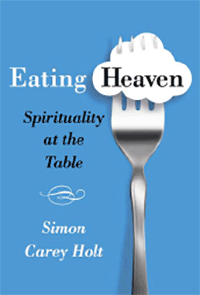
Join our Spiritual Reading Group at the Carmelite Centre on Tuesday 20 May 4.30pm-6.00pm as we explore Simon Carey Holt's book, Eating Heaven - Spirituality at the Table.
Sitting down at a table to eat is such a normal thing to do that we rarely ponder it beyond the simple inquiry, ‘What’s for dinner?’ Scratch a little deeper and you discover that it's something so laden with meaning and immersed in human longing and relationship that it takes on sacred dimensions. No wonder eating and drinking are mentioned so much in the Scriptures.
Simon Carey Holt is a trained chef, teacher, social researcher, minister of religion and homemaker. In this book, he draws on experience and research to explore the role of eating in our search for meaning and community. He invites us to sit at the tables of daily life – from kitchen tables to backyard barbecues, from cafe tables to the beautifully set tables of Melbourne’s finest restaurants – and consider how our life at these tables interacts with our deepest values and commitments.
More information & bookings: (03) 9690 5430 | This email address is being protected from spambots. You need JavaScript enabled to view it. | www.thecarmelitecentremelbourne.org
![]() Eating Heaven - Spirituality at the Table (52.87 kB)
Eating Heaven - Spirituality at the Table (52.87 kB)
Sancta Sophia hosts Harmony Festival Events
Fr Ken Petersen OCarm and Sr Kathleen Murphy OP will host an Inter-Faith Forum and an Inter-Faith Service as part of the 2014 Warburton Harmony Festival. The Festival, billed as "a unique celebration of belonging, hosted by a creative community in a beautiful environment", runs from 16-19 May.
The Inter-Faith Forum will be held from 2.00pm - 4.00pm and the Inter-Faith Service from 4.30pm-6.00pm on Sunday 19 May in the Mechanics Hall, Warburton. Both events will involve people from a variety of faith traditions.
British Carmelites elect new Provincial Council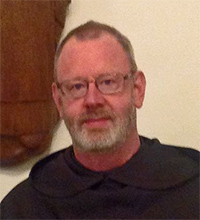
The British Carmelites gathered for their Provincial Chapter on 25-28 February and 5-9 May 2014 at Aylesford Priory, Kent.
During the Chapter a new Provincial and Council was elected:
Prior Provincial: Fr Antony Lester (pictured)
First Councillor: Fr Kevin Melody
Second Councillor: Fr Damian Cassidy
Third Councillor: Fr Francis Kemsley
Fourth Councillor: Br Paul Jenkins
Remembering Dom Bede Griffiths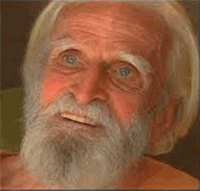
You are invited to join the Sancta Sophia Meditation Community, Warburton, to celebrate the life and message of Bede Griffiths. Embraced by Love is the theme of a day of readings, chants, meditation and the Eucharist on Saturday 10 May 10.00am to 3.00pm.
Cost: $30.00. Please bring some lunch to share.
Bookings: (03) 5966 2120.
Whitefriars College Remembers ANZACs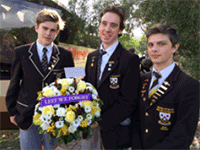
Mark Angelovski, Lachlan Mahon and Jack Schroder represented Whitefriars College at the Anzac Day ceremony held in Templestowe Park on Thursday 24 April.
The Ceremony was attended by hundreds of students and teachers from schools in the surrounding Manningham area as well as Members of Parliament and the Mayor of Manningham.
Each school had an opportunity to lay a wreath at the memorial.
"The ceremony gave an opportunity for students to pay their respects to soldiers who had given up their lives for our country. It was great for Whitefriars to be involved in this community event and we were glad to be there representing the College, to pay respects to
those that fought in the wars representing Australia" Whitefriars College Student, Jack Schroder said.
JPIC Newsletter - May 2014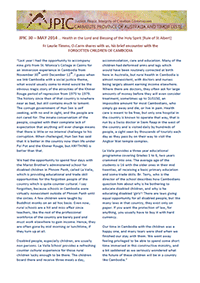
May 2014
The May issue of the Justice, Peace and Integrity of Creation Newsletter is now available.
In this issue
- Forgotten children of Cambodia
- Carmelite Tradition: Option for the Poor
- Church Tradition: Pope Francis
- JPIC Calendar for May
- Prayerful Reflections for this month
Lectio Divina - May 2014
May 2014
You can download and save the scripture texts, reflections and prayers for Lectio Divina for each day of this month by clicking the link at the end of this story. Available in pdf format or eBook (for your iPhone/iPad) or your Kindle.
Lectio Divina is a traditional way of praying the Scriptures so that the Word of God may penetrate our hearts and that we may grow in an intimate relationship with the Lord.
It is a very natural way of prayer and was developed and practised by the early monks and so came to the first Carmelite hermits. Visit our Lectio Divina page. These texts are prepared by a group of international Carmelites to help all those who use the Lectio Divina method of praying with the scriptures.
![]() Lectio Divina 2014 pdfMay (803.08 kB) |
Lectio Divina 2014 pdfMay (803.08 kB) | ![]() Lectio Divina May 2014 iPad/iPhone (376 kB)
Lectio Divina May 2014 iPad/iPhone (376 kB) ![]() Lectio Divina May 2014 Kindle (389.82 kB)
Lectio Divina May 2014 Kindle (389.82 kB)
Fr Wayne Appointed to International Commission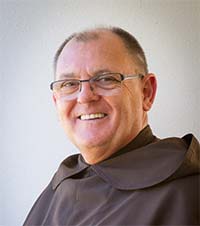
April 2014
Fr Wayne Stanhope, Director of Formation for our Province, has been appointed to the International Carmelite Formation Commission. The Commission is responsible for offering international opportunities for ongoing formation for Carmelites, courses for those involved in formation ministry and for continuously updating the Order's fundamental document on formation, the Ratio Institutionis Vitae Carmelitanae.
The latest version of the RIVC has just been published under the English title: Carmelites Formation: A Journey of Transformation (see below).
The new International Commission will hold its first meeting in Rome towards the end of May.
New Carmelite Formation Document published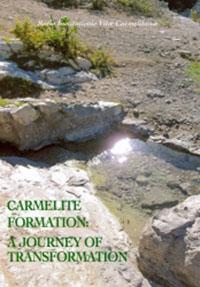
April 2014
A new edition of the Ratio Institutionis Vitae Carmelitanae, the Order's fundamental document on formation has been released.
Known as the Ratio or RIVC for short it has recently been printed in book form in English, under the title Carmelite Formation: A Journey of Transformation.
The new edition has changes suggested by Provincials and Formators across the Order. New or revised additions relate to the vows, human development, silence, liturgy, work, inculturation and child protection. These texts were presented and refined at two international gatherings of Formators and Provincials.
Announcing the release of the new Ratio, Fr Fernando Millán (Prior General) said, "formation is not only something that is academic and intellectual. It is also a question of an attitude that is both spiritual and life-oriented". Such an attitude "means to remain always attentive to the will of God and to our identity, which is fundamentally a response to that will, and to the signs of the times, through which, despite all their ambiguity, God is communicating something to us."
"I believe that we can all be enriched by reading it and we can feel challenged and encouraged in our vocation, whatever our age may be or whatever stage of formation we find ourselves in now," he said.
Catching Up - New Novices received last December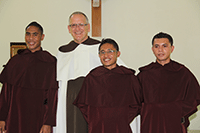
Cesaltino Dos Santos, Juliao Dos Santos and David Soares began the first year of their novitiate on 14 December 2013. Fr Bruce Clark (Regional Prior and Novice Master) formally admitted them in a ceremony at Sáo Elijah community chapel. Carmelites from Timor Leste attended the ceremony together with many family members and friends of Cesaltino, Juliao and David.
The reception of Cesaltino, Juliao and David bring the total number of novices belonging to our Province to ten.
See more photos of the Reception Ceremony.
Carmel Contact No 95 - April 2014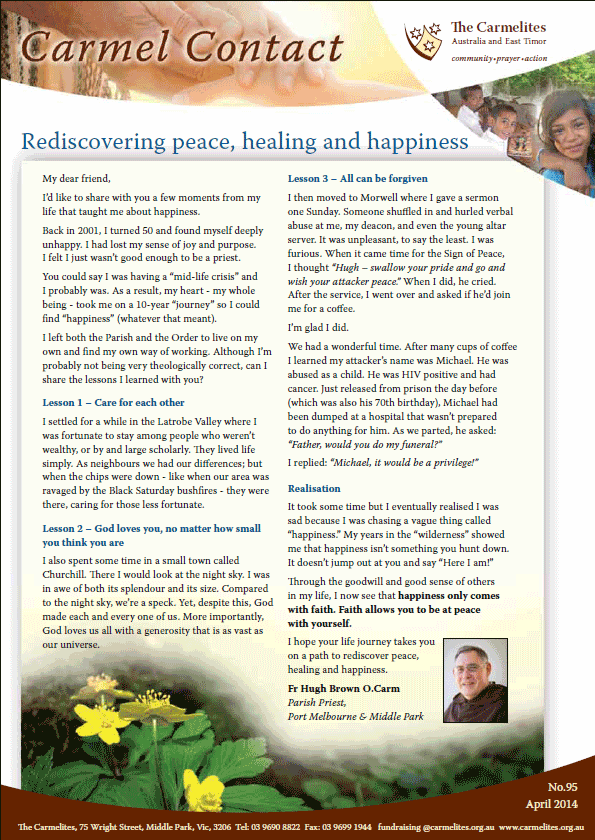
In this issue
- Rediscovering peace, healing & happiness
- Faith & Healing for all Australians
- Mass of Healing & Anointing - 24 May, National Shrine
- A Whole new world - Luke Murphy, a student at Whitefriars College,
writes about his experiences in East Timor - Mt Carmel, Coorparoo, raises $18,000 for East Timor
- Mary in the Carmelite Tradition
- Message from Fr Denis - Our Future Leaders
- Fr Peter Byrth RIP
- Your generosity raised $583,000 last year for our communities in Australia & East Timor
- Order your Carmelite Prayer Cards now
![]() Carmel Contact No 95 (795.53 kB)
Carmel Contact No 95 (795.53 kB)
JPIC Newsletter - April 2014
April 2014
The April issue of the Justice, Peace and Integrity of Creation Newsletter is now available.
Special Theme: Walking with Pope Francis on the road to Justice, Peace and Ecology
- in the words of Pope Francis:
- Inclusion Vs Exclusion
- Throwaway Society
- Poverty
- Common Good
- Women
- Gospel & Politics DO mix
- Prayerful Reflection for this month
- Prayers for passengers & crew on Flight MH307
Lectio Divina - April 2014
April 2014
You can download and save the scripture texts, reflections and prayers for Lectio Divina for each day of this month by clicking the link at the end of this story. Available in pdf format or eBook (for your iPhone/iPad) or your Kindle.
Lectio Divina is a traditional way of praying the Scriptures so that the Word of God may penetrate our hearts and that we may grow in an intimate relationship with the Lord.
It is a very natural way of prayer and was developed and practised by the early monks and so came to the first Carmelite hermits.Visit our Lectio Divina page.These texts are prepared by a group of international Carmelites to help all those who use the Lectio Divina method of praying with the scriptures.
![]() Lectio Divina April 2014 pdf (877.7 kB)
Lectio Divina April 2014 pdf (877.7 kB) ![]() Lectio Divina April 2014 iPad/Kindle (438.13 kB)
Lectio Divina April 2014 iPad/Kindle (438.13 kB) ![]() Lectio Divina April 2014 epub (416.09 kB)
Lectio Divina April 2014 epub (416.09 kB)
JPIC Newsletter - March 2014
March 2014
The March issue of the Justice, Peace and Integrity of Creation Newsletter is now available.
In this issue:
- Fr Denis looks at electoral justice in Timor Leste
- East Timor Oil & Gas dispute
- March JPIC Calendar
- Carmelite Constitutions on Justice
- Prayerful Reflections for you to use
St Nuno's Celebration moves to 6 November
Feburary 2014
The memorial of St Nuno Alvarez Periera (Carmelite and patron saint of Portugal) has been changed from 1 April to 6 November.
The previous date, normally in Lent or the Octave of Easter, meant that St Nuno's feast was not often able to be celebrated.
The online version of the 2014 Carmelite Liturgical Guide has been updated to reflect this change.
JPIC Newsletter - February 2014
February 2014
The February issue of the Justice, Peace and Integrity of Creation Newsletter is now available.
In this issue:
- Fr Laurie reports from the SHERGER Detention Centre
- February JPIC Calendar
- Carmelite Constitutions on Justice
- Prayerful Reflections for you to use
![]() JPIC February 2014 (867.13 kB)
JPIC February 2014 (867.13 kB)
2014 Carmelite Liturgical Guide
January 2014
Carmelite Communications has published the 2014 Carmelite Liturgical Guide. The Guide lists the various Carmelite solemnities, feasts and memorials as well as the usual liturgical celebrations of the Roman Calendar. The Guide is an indispensable help to those wishing to celebrate Mass and the Prayer of the Church according to the Carmelite Calendar.
In the online version below you can use the "Bookmarks" to quickly choose the current month.
Copies of the Guide can be purchased from Carmelite Communications for $5.00 plus postage.
You can download the Guide here: ![]() 2014 Carmelite Liturgical Guide (240.51 kB)
2014 Carmelite Liturgical Guide (240.51 kB)
The Vine - December 2013
December 2013
The December issue of the Vine is now available.
In this issue:
- Central Coast Community celebrates 50 years
- From Christine Wade, the new Moderator
- Thank you from Fr Jim
- New Lay Carmelite National Council
- News from communities
![]() The Vine 24.4 December 2013 (1.88 MB)
The Vine 24.4 December 2013 (1.88 MB)
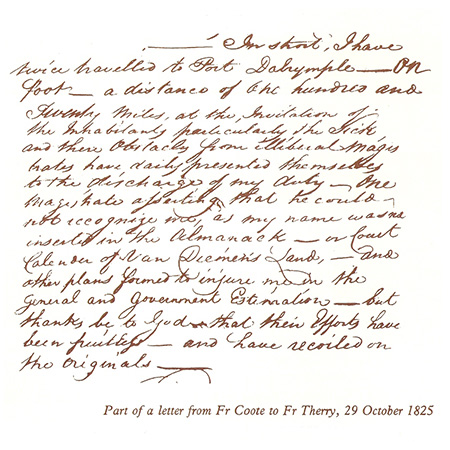 The story of Fr Samuel Coote, OCarm
The story of Fr Samuel Coote, OCarm
1824-25
In 1824 a Carmelite priest arrived in Australia. He was Fr Samuel Coote, a Kilkenny man who studied at Maynooth and was ordained in 1818. Although he was only the fourth priest to come free to work on the Australian continent, he is a little known and rather neglected figure in Australian Catholic history.
He was known to the family of Fr Therry in Cork, and it was perhaps through them that he came to be interested in the Australian mission. In September 1823 he secured official government permission to minister to Catholics in Van Diemen's Land, and sailed from Ireland in the Ardent that November, arriving in Hobart in Mary 1824. There he met with a cool reception from the resident chaplain, Fr Conolly.
It is difficult now to reconstruct exactly what happened. Although Fr Coote had letter of introduction from the British Colonial Office and from Dr Poynter, the Vicar Apostolic of London, Fr Conolly seems to have objected that he did not have the necessary faculties from Dr Slater of Mauritius, the bishop responsible for New Holland. As a return of correspondence with Mauritius could take up to two years, Conolly in the meantime gave permission for Coote to minister at some of the outlying settlements, celebrating Mass on Sundays and teaching the children catechism. Fr Coote moved about the smaller settlements, and seems to have impressed the Catholic settlers in many of them.
Fr Conolly, however, was a hard man to impress, and within a few month the two priests had fallen out: Conolly forbade Coote to exercise his ministry, and Coote sought to replace Conolly as the official Catholic chaplain. In April 1825, 169 free Catholic settlers (probably a goodly proportion of the Catholic population at the time) petitioned the Governor, expressing their satisfaction with Fr Coote's work for themselves and their children. "This rev. gentleman has officiated in several districts", they wrote, "and the conciliatory and pious manner in which he has invariably conducted himself since his arrival in this colony, his unremitting endeavours in instruction in this confined sphere of action, and his disinterested behaviour have secured for him the highest esteem." At the same time they complained of Fr Conolly's failure to complete the Hobart chapel, despite the provision of funds for the purpose.
The Governor, however, was not prepared to support Fr Coote and in December 1825 he left the colony for England, never to return. Columbus Fitzpatrick remembers that he spent some time in Sydney, but whether he had any contact with the other two Carmelites in Sydney at this time, James Dempsey and John Butler, we now have no way of knowing. He died in London of consumption on 18 September 1837, aged fifty.
Fr Paul Chandler, OCarm
Although the first official Carmelites foundation in this country was made in 1881, the first Carmelites in Australia had arrived nearly eighty years before. They were the Lay Carmelites (Tertiaries or Confraternity members) James Dempsey and John Butler. Both were transported to Botany Bay for life for their alleged involvement in the Irish Rebellion of 1798.
There are many famous Carmelites who have influenced generations of spiritual seekers throughout the Order's history. Here are just some of them.
 Saint Albert of Jerusalem was born in Emilia, Italy in the mid 12th Century. He became a Canon Regular of the Holy Cross at Mortara (Pavia) where he was elected Prior in 1180. He was appointed Bishop of Bobbio in 1184 and of Vercelli the following year. During his 20 years there he undertook a number of missions of national and international importance. He brokered peace between the cities of Pavia and Milan in 1194 and between the cities of Parma and Piacenza in 1199. In 1191 he held a Diocesan Synod, the statutes and decrees of which continued to serve as a norm until modern times.
Saint Albert of Jerusalem was born in Emilia, Italy in the mid 12th Century. He became a Canon Regular of the Holy Cross at Mortara (Pavia) where he was elected Prior in 1180. He was appointed Bishop of Bobbio in 1184 and of Vercelli the following year. During his 20 years there he undertook a number of missions of national and international importance. He brokered peace between the cities of Pavia and Milan in 1194 and between the cities of Parma and Piacenza in 1199. In 1191 he held a Diocesan Synod, the statutes and decrees of which continued to serve as a norm until modern times.
In 1205 he was elected Patriarch of Jerusalem and soon after nominated as papal legate for the ecclesiastical province of Jerusalem. He arrived in Palestine early in 1206, taking up residence at Acre, at the foot of Mount Carmel, as Jerusalem was occupied by the Saracens. In Palestine he continued his peace-making efforts not only between Christians but also between them and non-Christians.
On 14 September 1214 he was stabbed to death during a procession to celebrate the Feast of the Exaltation of the Cross by the Master of the Hospital of the Holy Spirit whom Albert had denounced for his unjust and abusive behaviour.
Somewhere between his arrival in Palestine in 1206 and his death in 1214 the first group of Carmelites asked Albert to write for them a "formula of life" which later became the Carmelite Rule approved by Pope Innocent VI in 1247.
 Saint Teresa of Avila, who almost single handedly reformed the order in the 16th century, was responsible for the establishment of the Discalced Carmelites in the latter part of the century. Her life was a colourful and supernatural series of events that had amazed and awed observers and followers of the order for centuries. Teresa was born in Avila in Spain in 1515. She entered the Carmelites and made great progress in the way of perfection and was granted mystical revelations. Wishing to share in the spiritual renewal of the Church of her time, she began to live her religious life more ardently and soon attracted many companions, to whom she was like a mother. She also helped in the reform of the friars with Saint John of the Cross, and in this had to endure great trials. She wrote books which are renowned for their depth of doctrine and which showed her own spiritual experiences. She died at Alba de Tormes in 1582. In 1970 Teresa was declared a Doctor of the Church by Pope Paul VI.
Saint Teresa of Avila, who almost single handedly reformed the order in the 16th century, was responsible for the establishment of the Discalced Carmelites in the latter part of the century. Her life was a colourful and supernatural series of events that had amazed and awed observers and followers of the order for centuries. Teresa was born in Avila in Spain in 1515. She entered the Carmelites and made great progress in the way of perfection and was granted mystical revelations. Wishing to share in the spiritual renewal of the Church of her time, she began to live her religious life more ardently and soon attracted many companions, to whom she was like a mother. She also helped in the reform of the friars with Saint John of the Cross, and in this had to endure great trials. She wrote books which are renowned for their depth of doctrine and which showed her own spiritual experiences. She died at Alba de Tormes in 1582. In 1970 Teresa was declared a Doctor of the Church by Pope Paul VI.
 Saint John of the Cross was born at Fontiveros in Spain about 1542. He entered the Carmelites and with the permission of his superiors began to live a stricter life. Later he was persuaded by St Teresa to begin, together with some others, a reform within the Carmelite friars which cost him much hard work and many trials. He died in Ubeda in 1591, outstanding in holiness and wisdom, to which his many spiritual writings give eloquent witness. His writings were first published in 1618. After his death the reform he introduced within the friars eventually separated from the Carmelite Order to become the Order of Discalced Carmelite Friars. John was canonised in 1726 and declared a Doctor of the Church in 1926.
Saint John of the Cross was born at Fontiveros in Spain about 1542. He entered the Carmelites and with the permission of his superiors began to live a stricter life. Later he was persuaded by St Teresa to begin, together with some others, a reform within the Carmelite friars which cost him much hard work and many trials. He died in Ubeda in 1591, outstanding in holiness and wisdom, to which his many spiritual writings give eloquent witness. His writings were first published in 1618. After his death the reform he introduced within the friars eventually separated from the Carmelite Order to become the Order of Discalced Carmelite Friars. John was canonised in 1726 and declared a Doctor of the Church in 1926.
Famous Carmelites of the 20th Century include
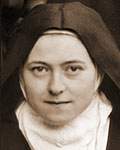 Saint Therese of Lisieux, one of only four women Doctors of the Church, so named because of her famous teaching on the 'way of confidence and love' set forth in her best-selling memoir, 'Story of a Soul'. Thérèse Martin was born in Alencon in France in 1873. Whilst still young she entered the Discalced Carmel of Lisieux, where she lived - as Sister Thérèse of the Child Jesus and the Holy Face - in the greatest humility and evangelical simplicity and confidence in God. By word and example she taught the novices these same virtues.
Saint Therese of Lisieux, one of only four women Doctors of the Church, so named because of her famous teaching on the 'way of confidence and love' set forth in her best-selling memoir, 'Story of a Soul'. Thérèse Martin was born in Alencon in France in 1873. Whilst still young she entered the Discalced Carmel of Lisieux, where she lived - as Sister Thérèse of the Child Jesus and the Holy Face - in the greatest humility and evangelical simplicity and confidence in God. By word and example she taught the novices these same virtues.
Offering her life for the salvation of souls and the spread of the Church, she died on 30 September 1897. She was 24 years old. She was declared a Doctor of the Church in 1997.
 Blessed Titus Brandsma, a Dutch scholar and writer who was killed in Dachau Concentration Camp because of his stance against Nazism. Born at Bolsward (The Netherlands) in 1881, Titus joined the Carmelite Order as a young man. Ordained priest in 1905, he obtained a doctorate in philosophy in Rome. He then taught in various schools in Holland and was named professor of philosophy and of the history of mysticism in the Catholic University of Nijmegen where he also served as Rector. He was noted for his constant availability to everyone and for his concern for his students for whom he collected food, clothing and blankets.
Blessed Titus Brandsma, a Dutch scholar and writer who was killed in Dachau Concentration Camp because of his stance against Nazism. Born at Bolsward (The Netherlands) in 1881, Titus joined the Carmelite Order as a young man. Ordained priest in 1905, he obtained a doctorate in philosophy in Rome. He then taught in various schools in Holland and was named professor of philosophy and of the history of mysticism in the Catholic University of Nijmegen where he also served as Rector. He was noted for his constant availability to everyone and for his concern for his students for whom he collected food, clothing and blankets.
He was a professional journalist, and in 1935 he was appointed ecclesiastical advisor to Catholic journalists. Both before and during the Nazi occupation of The Netherlands he fought, faithful to the Gospel, against the spread of the Nazi ideology and for the freedom of Catholic Education and the Catholic Press. For this he was arrested and sent to a succession of prisons and concentration camps where he brought comfort and peace to his fellow prisoners and did good even to his tormentors. In 1942, after much suffering and many humiliations, he was killed by lethal injection at Dachau. He was beatified by John Paul II on 3 November 1985.
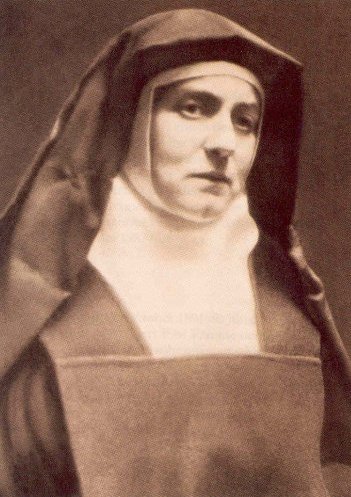 Saint Teresa Benedicta of the Cross, a Jewish convert to Catholicism who was also imprisoned and died at Auschwitz. Edith Stein was born to a Jewish family at Breslau on 12 October 1891. Through her passionate study of philosophy she searched after truth and found it in reading the autobiography of St Teresa of Jesus (Avila). In 1922 she was baptised and in 1933 she entered the Carmel of Cologne where she took the name Teresa Benedicta of the Cross. She was gassed and cremated at Auschwitz on 9 August 1942 during the Nazi persecution and died a martyr for the Christian faith after having offered her holocaust for the people of Israel. A woman of singular intelligence and learning, she left behind a body of writing notible for its doctrinal richness and profound spirituality. She was beatified by Pope John Paul II at Cologne on 1st May 1987, and canonised by him in 1998. In 1999 she was declared one of the six patron saints of Europe.
Saint Teresa Benedicta of the Cross, a Jewish convert to Catholicism who was also imprisoned and died at Auschwitz. Edith Stein was born to a Jewish family at Breslau on 12 October 1891. Through her passionate study of philosophy she searched after truth and found it in reading the autobiography of St Teresa of Jesus (Avila). In 1922 she was baptised and in 1933 she entered the Carmel of Cologne where she took the name Teresa Benedicta of the Cross. She was gassed and cremated at Auschwitz on 9 August 1942 during the Nazi persecution and died a martyr for the Christian faith after having offered her holocaust for the people of Israel. A woman of singular intelligence and learning, she left behind a body of writing notible for its doctrinal richness and profound spirituality. She was beatified by Pope John Paul II at Cologne on 1st May 1987, and canonised by him in 1998. In 1999 she was declared one of the six patron saints of Europe.
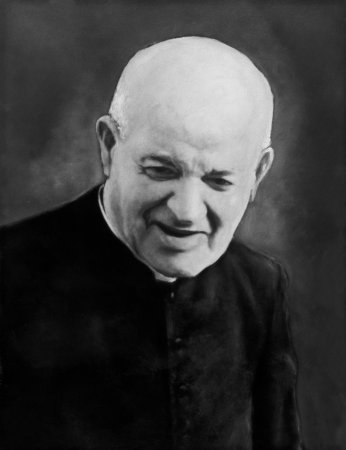 Saint George Preca was born in Valletta, Malta, on 12 February 1880. Ordained priest in 1906, he immediately began working with young people. In 1907 he founded the Society of Christian Doctrine, commonly known as M.U.S.E.U.M. (Magister Unitam Sequatur Evangelium Universus Mundus). He dedicated his life to preaching and teaching. His effective ministry was the fruit of a life of prayer and constant meditation on the Sacred Scriptures. On 21st July 1918, Fr George was received into the Carmelite Third Order and one year later, on 26th July 1919, he made his profession. In 1952 he was 'affiliated' to the Order as a recognition of his efforts to spread devotion to the Blessed Virgin Mary under the title of Our Lady of Mount Carmel. He died on 2nd July 1961 and was beatified by Pope John Paul II on 9 May 2001, and canonised by Pope Benedict XVI on 3 June 2007. His canonisation made Saint George the first member of the Carmelite Third Order to be formally recognised by the Church as a saint.
Saint George Preca was born in Valletta, Malta, on 12 February 1880. Ordained priest in 1906, he immediately began working with young people. In 1907 he founded the Society of Christian Doctrine, commonly known as M.U.S.E.U.M. (Magister Unitam Sequatur Evangelium Universus Mundus). He dedicated his life to preaching and teaching. His effective ministry was the fruit of a life of prayer and constant meditation on the Sacred Scriptures. On 21st July 1918, Fr George was received into the Carmelite Third Order and one year later, on 26th July 1919, he made his profession. In 1952 he was 'affiliated' to the Order as a recognition of his efforts to spread devotion to the Blessed Virgin Mary under the title of Our Lady of Mount Carmel. He died on 2nd July 1961 and was beatified by Pope John Paul II on 9 May 2001, and canonised by Pope Benedict XVI on 3 June 2007. His canonisation made Saint George the first member of the Carmelite Third Order to be formally recognised by the Church as a saint.
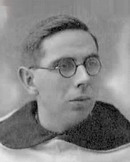 Blessed Hilary Januszewski was a Polish Carmelite born on 11 June 1907 and joined the Carmelites in September 1927. Following his studies and ordination in Rome he was appointed lecturer in Dogmatic Theology and in Church History for the students of the Polish province in Krakow. In 1939 he was appointed Prior of that community. World War II was to jeopardise all the hopes and projects of the young prior. On 1 September 1939, after several months of widespread international tension, Germany declared war on Poland. Twenty days later, Soviet troops launched an attack from the East. A year after the invasion, the invading forces ordered the arrest of large numbers of monks and priests. On 18 September five Carmelites were arrested including Fr Hilary, who offered to go instead of Fr Konoba, who was older than him and sick. In the concentration camp at Dachau he volunteered to look after prisoners suffering from typhus in the infamous Hut 25. After 21 days serving the sick, he died of typhus. Read the full story of Fr Hilary.
Blessed Hilary Januszewski was a Polish Carmelite born on 11 June 1907 and joined the Carmelites in September 1927. Following his studies and ordination in Rome he was appointed lecturer in Dogmatic Theology and in Church History for the students of the Polish province in Krakow. In 1939 he was appointed Prior of that community. World War II was to jeopardise all the hopes and projects of the young prior. On 1 September 1939, after several months of widespread international tension, Germany declared war on Poland. Twenty days later, Soviet troops launched an attack from the East. A year after the invasion, the invading forces ordered the arrest of large numbers of monks and priests. On 18 September five Carmelites were arrested including Fr Hilary, who offered to go instead of Fr Konoba, who was older than him and sick. In the concentration camp at Dachau he volunteered to look after prisoners suffering from typhus in the infamous Hut 25. After 21 days serving the sick, he died of typhus. Read the full story of Fr Hilary.
 St Elizabeth of the Trinity was born on 18 July 1880. As a young child she earned a reputation as an incessant chatterbox and vivacious crawler. She was strong-willed and determined. As she grew up she became known for her generous and loveable nature. She was an excellent musician whose concerts won critical acclaim. At the same time her awareness of God began to grow. In the midst of a busy social life she managed to find time to help with troubled youth and seemed to radiate the presence of God wherever she went. She entered the Carmelite Convent at Dijon in 1901. She was given the name 'Elizabeth of the Trinity'. Here she grew in the Carmelite attributes of reflective prayer, living in the present moment, loving God wholeheartedly and serving others with simplicity. Much like St Therese of Lisieux, Elizabeth's way was one of simple conversation with God and a deep, abiding awareness of God's presence within. Read the full story of St Elizabeth of the Trinity.
St Elizabeth of the Trinity was born on 18 July 1880. As a young child she earned a reputation as an incessant chatterbox and vivacious crawler. She was strong-willed and determined. As she grew up she became known for her generous and loveable nature. She was an excellent musician whose concerts won critical acclaim. At the same time her awareness of God began to grow. In the midst of a busy social life she managed to find time to help with troubled youth and seemed to radiate the presence of God wherever she went. She entered the Carmelite Convent at Dijon in 1901. She was given the name 'Elizabeth of the Trinity'. Here she grew in the Carmelite attributes of reflective prayer, living in the present moment, loving God wholeheartedly and serving others with simplicity. Much like St Therese of Lisieux, Elizabeth's way was one of simple conversation with God and a deep, abiding awareness of God's presence within. Read the full story of St Elizabeth of the Trinity.
Carmel Contact is a newsletter of the Carmelites of Australia and Timor Leste
Australian Carmelite Publications
International Carmelite Publications
Documents of the Carmelite Order
- Carmelite Constitutions
Approved by the General Chapter 1995 - Journeying With Carmel
Extracts from the Carmelite Constitutions 1995
Letters of the Prior General
- pdf Into the Land of Carmel - 25 May 2002
- The God of Our Contemplation - 1 January 2005
- pdf Passion for Christ, Passion for Humanity - 9 January 2005
- pdf That Carmel May Bloom - 27 March 2005
- The Lord Hears the Cry of the Poor - 1 March 2006
- pdf Blessed Maria Teresa Scrilli - 8 September 2006
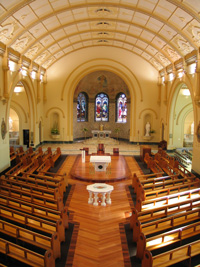 The National Shrine of Our Lady of Mount Carmel is located at the corner of Richardson and Wright Streets in Middle Park, Victoria, Australia.
The National Shrine of Our Lady of Mount Carmel is located at the corner of Richardson and Wright Streets in Middle Park, Victoria, Australia.
This Church of Our Lady of Mount Carmel was begun in 1912 and completed in 1928. It was dedicated as the National Shrine in 1944 and has been home to the Carmelite family in Australia since then.
Throughout the year special events are held at the Shrine during which we pray for the members of our Carmelite family and their needs.
These masses include the
- Mothers' Mass, celebrated on the Feast of Our Lady of Mount Carmel
- Mass of Remembrance, celebrated near to All Souls Day and All Saints Day
- Thanksgiving Mass, celebrated at midnight on Christmas Eve
The Church contains shrines to:
- Our Lady of Mount Carmel
- St Therese of Lisieux
- St Mary of the Cross Mackillop
- The Prophet Elijah
- The Sacred Heart
and is open 8.30-9.30am Tuesday, Thursday & Saturday mornings and 4.30-6.00pm Saturday evenings & 10.00am-12.00pm on Sundays.
For more information about how you can be part of these special events please contact the This email address is being protected from spambots. You need JavaScript enabled to view it.














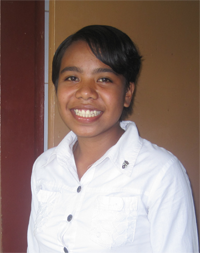 Then there's Gloria, who showed courage and initiative in asking The Carmelites for help.
Then there's Gloria, who showed courage and initiative in asking The Carmelites for help.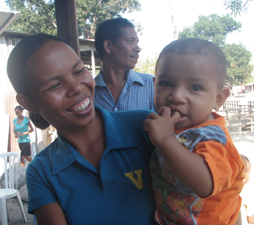 Lucinda is too ill to look after Louis, her 18 month old son. She has asked the Carmelites to find a family who will care for him. She hopes her son never experiences poverty. In order to grow up well, Louis will need lots of love, nutritious food, safe drinking water, vaccines to help build up his immune system and an education so he can eventually find work. For the next 18 years Louis will depend on caring people like you to help him grow up and break free from poverty.
Lucinda is too ill to look after Louis, her 18 month old son. She has asked the Carmelites to find a family who will care for him. She hopes her son never experiences poverty. In order to grow up well, Louis will need lots of love, nutritious food, safe drinking water, vaccines to help build up his immune system and an education so he can eventually find work. For the next 18 years Louis will depend on caring people like you to help him grow up and break free from poverty.
